









































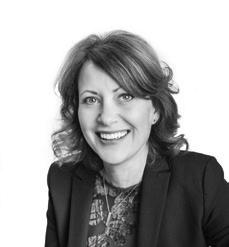
®

402.399.9233
1917
U nless you’ve been living under a rock, you’re aware of the frenzy around the series finale of “Succession” earlier this summer. The Emmy Award-winning HBO MAX drama chronicled ultra-wealthy and abusive patriarch Logan Roy’s cutthroat game to see which of his children, Kendall, Shiv, or Roman all entitled, self-interested, ethically challenged people would take over the family’s mega entertainment company, Waystar RoyCo, which has become a cesspool of toxic behavior and criminal activity. At times, the show was hard to watch for all the cruel behavior and obscenity, but like a terrible car accident, it was virtually impossible to look away.
In the real world, however, surveys suggest the vast majority of family-owned legacy companies do not fit the Waystar mold at all. In fact, they’re viewed as more employee-friendly, trustworthy, and customeroriented than the average business. Family owners are typically hardworking, more committed, and highly invested in the company’s success as well. The same things can be said of employee-owned businesses (ESOPs), which make up a growing number of legacy companies. Their longevity and success are directly linked to having created a respectful, collaborative work environment and owners having a “horse in the race.”
We feature several of these family- and employeeowned Omaha legacy companies in this issue of B2B, as well as profiles of inspiring and interesting professionals from other long-serving businesses in the metro…All Makes, Monarch Siding, Pinnacle Bank, Holland Basham Architects, to name a few. We honor their hard-earned success and thank them for their longtime contribution to our community. And in their case, we’re certainly glad life doesn’t imitate art.
EST. 1974 www.maxiwalker.com & www.maxiwalkeruniform.com
Since 1917, five generations of the Walker family have served the retail, and then the commercial, laundry markets in Omaha and the surrounding areas. We’re Dry Cleaners, but many Omaha business owners have also depended on our Uniform Rental Service since 1974.
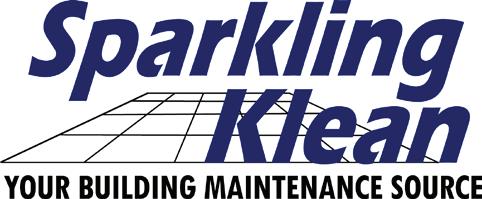
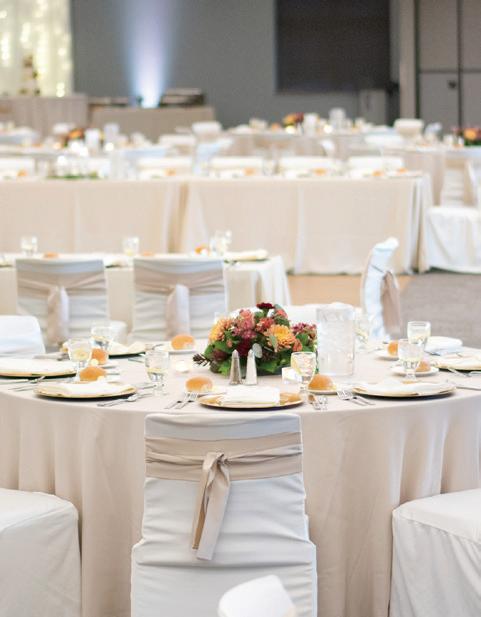




 AFTER HOURS | STORY BY KARA SCHWEISS | PHOTO BY BILL SITZMANN
AFTER HOURS | STORY BY KARA SCHWEISS | PHOTO BY BILL SITZMANN
When he’s not at his Papillion business Monarch Siding, Windows & Roofing, Tom Galgerud is probably on a pickleball court. Tennis had long been Galgerud’s racket sport of choice, but he’s favored pickleball since picking it up a few years ago.
“I LIKE THE QUICKNESS OF THE GAME. TENNIS MIGHT TAKE AN HOUR, HOUR AND A HALF TO PLAY A MATCH. WITH PICKLEBALL, IT’S 15, 20 MINUTES TO PLAY A MATCH. YOU CAN PLAY MULTIPLE MATCHES IN A DAY, MULTIPLE OPPONENTS IN A DAY, AND THAT DOESN’T TAKE FOREVER.”
since,” said George Quaiver, the pickleball player whose friendly enthusiasm brought Galgerud to the court for the first time. “Tom has entered numerous tournament competitions to get points and keeps improving and increasing his skill rating.”
Galgerud, a natural, is ascending the player ranks quickly.
“There are different levels in pickleball, and you kind of work your way up. I played my first competitive tournament a year ago July (2022 Cornhusker State Games). I wasn’t sure what level to enter because I’d never played a tournament before, and so I entered the 3.5 level, and we won the gold medal,” Galgerud said. “I moved up to the 4.0 level, and I’ve been playing that most of the last year. And now I’m just moving into the 4.5 [level].”
The pickleball community is well-connected virtually, too. Galgerud said he can schedule games via an app anywhere he’s traveling the lightweight equipment is easy to bring along and pickleball is played all around the Omaha metro area, with details online and on social media.
Pickleball is typically described as a hybrid of tennis, ping-pong, and badminton. It’s played on a smaller court than tennis or badminton, meaning less running, which is appealing to a wider age range and to people with varying levels of fitness. However, Galgerud said, “It’s a great way to exercise,” especially for players who take on several consecutive matches in a day like he’s apt to do so.
“I like the quickness of the game,” Galgerud said. “Tennis might take an hour, hour and a half to play a match. With pickleball, it’s 15, 20 minutes to play a match. You can play multiple matches in a day, multiple opponents in a day, and that doesn’t take forever.”
Galgerud discovered pickleball by chance.
“About two years ago, my fiance [Amy Rinowski] and I were working out at the Papillion Landing,” he said. “I’m watching these people play on the gym floor; I didn’t know what the sport was it’s not tennis, it’s not badminton, it’s not ping-pong it’s something else. This gentleman waved me in to come and try it…I was hooked from day one.”
“I struck up a conversation, explained the basics, got him a spare racket, and it’s been off to the races
Galgerud said he hoped to repeat gold at the State Games this summer. He won in mixed doubles and men’s doubles at the World Pickleball Tour Kansas City Challenger in late May.
Galgerud has found another benefit of pickleball: meeting potential new customers for his business, which focuses on residential work. Over his 30 years in business, he’s built Monarch’s reputation and has received many positive customer reviews online, as well as the Integrity Award from the Better Business Bureau.
“I chose Monarch to replace the roof on my house, in part because [Galgerud’s] business has been there as long as I have lived in Papillion, and I have had numerous neighbors use his services,” Quaiver said. “Tom also has a great crew working at the office for him while he’s out pickleballing.”
“I have different partners from tournament to tournament. And that particular tournament, I played mixed doubles with a gal that I’d never met before from Kearney,” Galgerud said. “I like the social aspect of pickleball. You get to meet so many new people.”
For more on Galgerud and Monarch Siding, visit monarchsiding.com. For more on Omaha’s pickleball scene, visit pbomaha.com.
B2B
-TOM GALGERUD
“I LIKE THE SOCIAL ASPECT OF PICKLEBALL. YOU GET TO MEET SO MANY NEW PEOPLE.”
-TOM GALGERUDHOW I ROLL | STORY BY JOEL STEVENS | PHOTOS BY BILL SITZMANN
Bob Grinnell wanted a car that was truly his own design. A vehicle combining modern performance and comfort, wrapped in a classic car shell.
Grinnell got his wish when he discovered “restomods” a car restoration and modification method utilizing modern parts and technology.
“You take an older car, and you take the body off the frame, you throw everything away: the interior, the drive train, the frame, the engine… and you put back in everything brand-new,” Grinnell said.
“It’s like building a new car from scratch that looks like an old car.”
Grinnell was bitten by the restomod bug five years and a handful of cars ago.
His current obsession: a glistening, metallic silver C2 Sting Ray Corvette that is a 1967 model on the outside and a 2022 version on the inside. At last year’s World of Wheels event, held at CHI Health Center in Omaha, Grinnell’s Corvette won Best Custom and the prestigious Heartland Award, presented to the vehicle deemed “Best in Show.”
“It was great,” Grinnell said of winning the award. “You rarely win two awards. But they thought enough of my car to give me two awards. I was very honored.”
Grinnell, a 65-year-old Omaha native, didn’t grow up a “gear head,” or “car guy,” but he’s loved classic American muscle cars since the day his dad brought home a 1969 Plymouth Road Runner.
Since 1975, Grinnell has owned and operated Surplus Sales of Nebraska, a specialty wholesaler of vintage and modern electronic parts. When not running the company’s day-to-day operations or dabbling in real estate he bought and later sold the 140,000-square-foot Mastercraft building at 13th and Nicholas in 2018 he’s showing his 1967 C2 or plotting his next restomod project.
The hobby he considers as much art as engineering began with a 1958 C1 Corvette. His other restomods include a 1967 Chevrolet Chevelle and a 1955 Chevrolet Nomad. He also owns a 2005 Dodge Viper, a 1956 Ford Thunderbird, and a 2023 CR8 Corvette Collector’s Edition.
But it’s his 1967 Corvette that’s his crown jewel one he rarely drives.
“You don’t want it chipped up. You have a car like this and you show it…it’s a commitment to keeping it pristine.”
Grinnell considers himself a “general contractor” on his restomods. Each mod entails hundreds of decisions: interior color and fabrics, paint color and number of coats, and engine specs among them.
Those decisions can be cheap or expensive. Grinnell has seen show cars with $1 million in modifications. Typically, he said, restomod budgets range from $150,000 to $400,000 for a classic car.
“You can be more exotic or you can be more frugal,” he said. “You can use used parts or a used, salvaged engine or new engine. It’s custom, and you can go anyway you want with it.”
There’s nothing he likes more than seeing the look on people’s faces when they approach his 1967 C2 expecting to see the classic factory engine and interior only to find a modern, 660-horsepower LT4 engine and dashboard for the 21st century. Grinnell admits some cars are better off simply being restored to their original.
“Buying an original 1953 Corvette and restomodding it would be thought of as not a good idea. There’s just so few of them. Leave them alone. Keep them original,” he urged.
That’s exactly why Grinnell talks through every modification and documents each and every step of the mod. It’s a painstaking process, like a work of art materializing on a steel canvas.
“I’ll keep going with it,” he said. “I’ve just hit retirement age, but I’ve taken on a lot of projects I’ve put off for a long time so I’m busy. But I would like to travel around the country with it [the 1967 Corvette] and do the World of Wheels tour. I hope to do it next year. There’s lots of things on my bucket list. Cars is just one big part of it.”
B2B
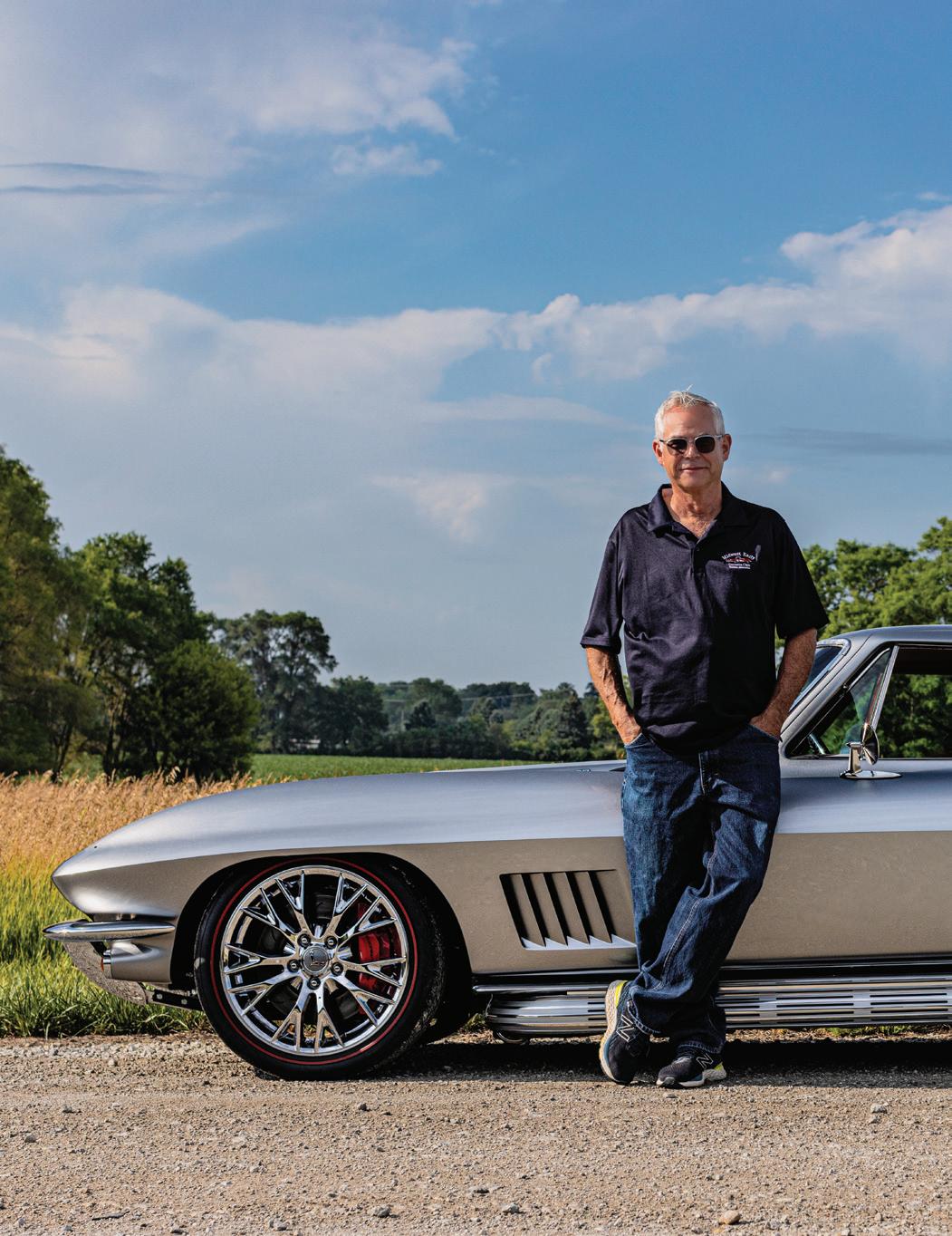







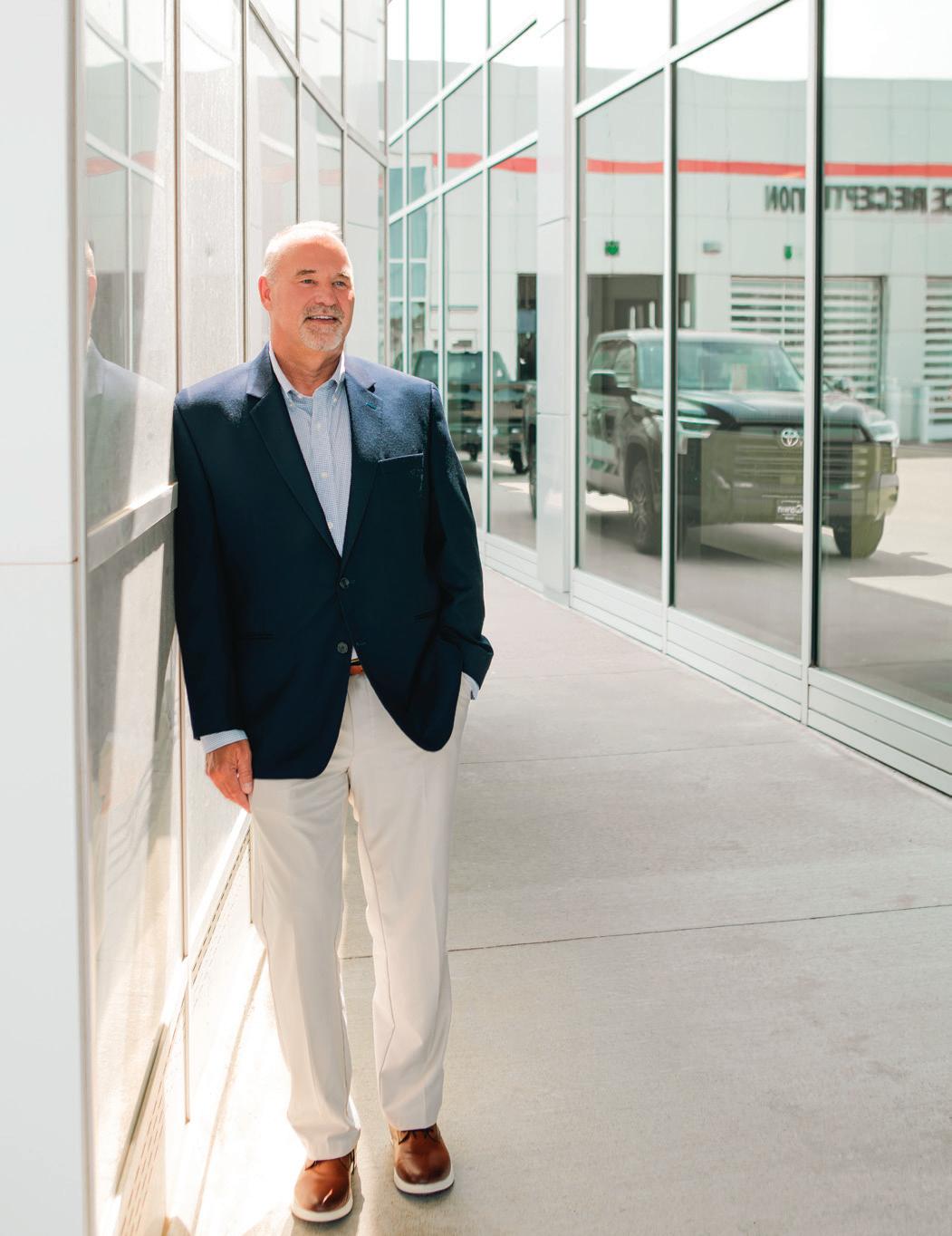
“IT WAS ROLLING UP THE SLEEVES AND COMING UP WITH A DESIGN THAT WORKED.”
-DEAN JESSICKLEMKE
If you drive past a Toyota dealership, chances are you’ll see a distinctive architectural piece in front of the entrance. It’s a large, glowing design element that acts as a kind of entryway for the building.
That piece, framed of steel and made with glass panels with an integrated fabric core, is called a portal, and Omaha’s own Dean Jessick is responsible for its creation.
It is, he said, the dealership’s marquee.
Jessick, who formerly owned Husker Glass, has been for almost 37 years president and CEO for Redglaze Group Holdings, which acts as the holding company for several businesses that provide architectural services for building owners and client companies across the globe. The firm is headquartered in Omaha.
It’s company SGH Concepts offers several services, including providing design assistance, cladding exteriors, integrating technology systems, daylighting, and sustainable design elements. One of its projects was the lantern atop the Holland Performing Arts Center, and it was this piece of work that got Toyota’s attention and brought them to Jessick’s team.
“The lighting effect or ‘glow’ of the Holland lantern was very appealing to [Toyota],” he said, “both as a fresh and striking impact and as a dealership statement to attract customers.”
Creating a new design element for its dealerships was part of Toyota’s overall rebranding efforts. The company, Jessick said, is very strict with its brand requirements and expected a lot from him and his team.
“We had to be under a continuous improvement model,” Jessick said, but working under such exacting standards helped make SGH a better company, he shared.
The proprietary design took about six months to complete. SGH and its vendors built the portal and achieved the glowing effect via an integrated fabric inside the glass.
“It was rolling up the sleeves and coming up with a design that worked,” Jessick said.
Designing the portal was one thing. The task of adding one to every Toyota dealership was another, especially since every portal has to fit the specific dealership. It has to be proportional to its building’s unique dimensions, comply with local ordinances, and withstand local weather, etc.
Fortunately for Toyota, Jessick and his team were able to address these requirements as well. Not only did they design and build the first portals; they also created a nationwide rollout program. They developed software and step-by-step instructions for guarantee every portal and exterior building facade met brand standards. Additionally, they vetted and contracted with installation teams across the country to make sure the years-long rollout process went smoothly. It takes approximately 16 weeks from engineering through completion for any given design application, Jessick said. Over 1,100 dealerships have been finished to date.
Now the portal feature appears in all of Toyota’s nationwide commercials. It has also prompted other auto manufacturers to try and copycat their own versions of portals a kind of “portal envy,” Jessick said. SGH continues to work with several other companies that have nationwide rollout programs.
Providing this range of service, from design to project management, is not typical in the industry. Jessick is proud of the work his company does and the fact that it’s employee-owned.
“You can still provide a really economical solution for people, but that requires trust,” he said. “I really believe in the legacy we’ve created.”
Visit sghconcepts.com for more information. Visit toyota.com for dealership portal photos.
B2B
“THE LIGHTING EFFECT OR ‘GLOW’ OF THE HOLLAND LANTERN WAS VERY APPEALING TO [TOYOTA], BOTH AS A FRESH AND STRIKING IMPACT AND AS A DEALERSHIP STATEMENT TO ATTRACT CUSTOMERS.”
-DEAN JESSICKIN THE OFFICE | STORY BY LISA LUKECART | PHOTOS BY BILL SITZMANN
The economic bubble burst in the final months of 1930. Panicked Americans raced to their banks to make withdrawals, forcing closures, especially in small rural communities that lacked reserves. Confidence in the financial system continued to erode, and three years later, 28 US states were left without a single bank.
Farmers George and Tom Dinsdale helped change the banking industry trajectory in 1938 by opening Pinnacle Bank in their hometown of Palmer in rural central Nebraska. The familyowned financial institution would later expand into eight states, growing while keeping its strong sense of community intact.
Dusty cornfields and the Great Depression remain integral parts of its financial past, but a bright, more urban future is projected in the contemporary stylings of Pinnacle Bank’s commercial buildings’ architecture and interior design. Each of the bank’s branches has a similar look with a unique twist.
Primary goals in concept design include security, safety, transparency, and functionality, with consideration given to consistent branding and a goal of looking innovative not too traditional or stuffy.
The Pinnacle branch at 84th and West Dodge Road represents the company’s design theme well. A perforated, layered metal building facade, serving as backdrop to its name and logo signage, draws looks from thousands of passersby daily at the busy intersection. More brand signage overlays high-performance glass windows on two sides of the building’s upper level, offering additional architectural interest. Avant Architects designed the contemporary 16,600-square-foot building, while Darland Construction acted as general contractor.
The branch’s welcoming, modern aesthetic continues through its sunlit front doors, which provide direct accessibility to the teller stations. Frosted glass panels at the counter hide computers and accessories, creating a more personal, high-end retail experience. Gray quartz countertops with black veining lend a sophisticated and calm ambiance. High-back tan chairs dotted with a geometrical pattern pair well with a burnt-orange patterned rug in a waiting area that invites customers to enjoy their respite. A laminated wood-grain screen creates a focal point while providing privacy for the teller and drive-thru employees.
Chris Wendlandt “never sacrifices design” for functionality, service, and safety. The retail marketing senior vice president started 27 years ago as a teller with Pinnacle Bank, so she sees the perspective from both sides of the counter.
“I love doing every piece of it,” said Wendlandt, who serves as a project manager of sorts, assembling each design-build team and throwing a party for each branch once it’s finished.
Exposed ceilings featuring snowy-white and blonde-wood accents and wooden slat-screen walls simultaneously warm the main room and define spaces. Frosted globe pendant lights illuminate tidy work stations for customers to fill out forms. Another area allows a place to sit on cushioned, modern stools. Sliding doors and veneer paneling conceal a coat room and the employee break area. Orange, black, and brown carpet tiles add visual interest and make it easy to modify the palette.
A hi-tech lightsaber LED experience consumes the eyes with crisscrossing linear track lights after walking past the bank into the shared lobby.
Concrete slate floors complement the large-format porcelain slabs. A custom-made art installation adds stained glass pops of mustard yellows, dark blues, and forest greens. The black frame bottom echoes the triangulation design of the white walls. It includes a sense of colorful concealment for occupants who want to work in the maroon cushioned lounge chairs behind it. Live plants breathe natural energy into the area.
“It’s interesting in a subtle way…An interplay between basic and rich,” said Avant Vice President Larry Smith, who has worked on several Pinnacle Bank projects through the years.
“We wanted to make it luxurious in a raw space,” Avant’s interior designer Hannah Wignall added.
Smith designed Pinnacle’s 132nd and Dodge building back in 1996. The connection cements his almost 30-year relationship with the bank. In fact, Avant leases space on the second floor of Pinnacle’s 84th and Dodge location. A shared conference room downstairs promotes collaboration.
The team recently finished another Pinnacle Bank near Werner Park at 126th and Highway 370. It’s hard to miss since the lights on one part of the building change, depending on the occasion: blue for a Creighton basketball game, pink for Valentine’s Day, or orange for Halloween.
“It’s forward-thinking,” Smith concluded.
Visit pinnbank.com for more information. For more Avant project galleries, visit avant-architects.com.
B2B

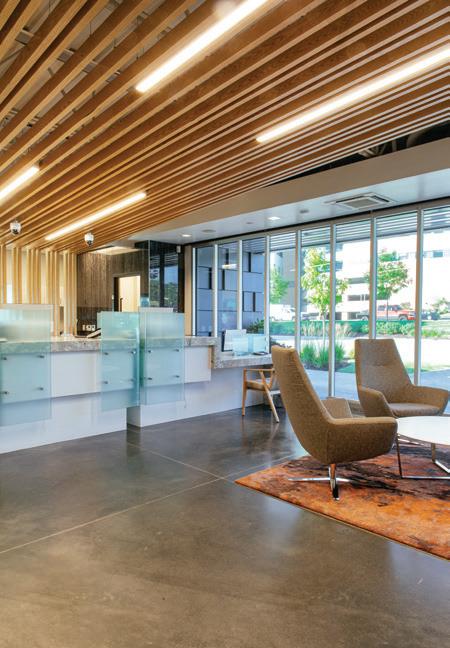
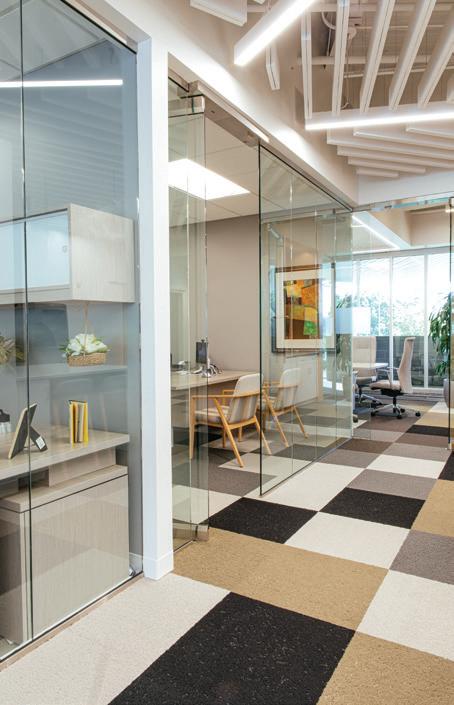
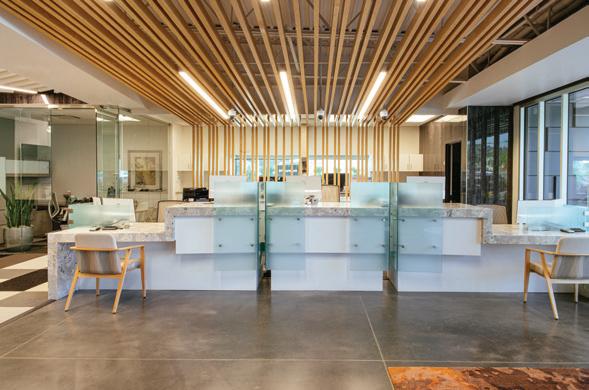
 | STORY BY SARA LOCKE | PHOTO BY BILL SITZMANN
| STORY BY SARA LOCKE | PHOTO BY BILL SITZMANN
Although Davielle Phillips has the talent and opportunity to utilize his education, experience, and creativity anywhere in the world, the young architectural designer is bestowing his gifts on Omaha.
Born and raised in Chicago’s South Side, Phillips recognized early on that the design of his city’s neighborhoods depended largely on the prosperity of its inhabitants. His passion for creating a more equitable, beautiful future took root, and by 2019 the young professional had achieved a Master of Architecture and a Master of Business Administration from University of NebraskaLincoln. He quickly found a home with Holland Basham Architects.
“Being in the architecture profession, I get to learn early on about projects being planned in Omaha,” Phillips said. “Omaha is a really good fit for me. I get to mix my architecture and business education with my passion for giving back. There are so many opportunities for everyone to get involved and to make impactful changes.”
That desire to find an outlet for his philanthropic spirit yielded a conversation with Tim Holland, founding principal at Holland Basham.
“Tim was involved with the Boys & Girls Club when he was a kid, and talked about how much he loved the opportunities he found through that involvement,” Phillips recalled. “I told him how passionate I was about the work the club was doing and asked if there was a way for me to get involved. Later that week he approached me about the Programs Committee.”
Phillips is currently serving as the architectural designer on the new Micah House emergency housing and early childhood educational facility. He is also using his time to share his experiences with the children at local elementary schools, at Rubicon Academy at The Hope Center for Kids, and at UNL’s National Organization of Minority Architects (NOMAS).
“I met the right people and told them I wanted to be involved. That was all it took…being vocal about what I had to give,” he said. “I see myself becoming an educator in the future, and I take every opportunity I can to be part of things I’m passionate about.”
That drive hasn’t gone unnoticed by Holland Basham’s senior staff. Managing Principal Curt Witzenburg’s admiration for Phillips is palpable as he discusses the young leader’s place within the company.
“The firm was initially built on the roots of giving back through time and talent,” Witzenburg recalled. “It was a key part of how the business was to interact with the community. We create opportunities for our staff to get involved, and to foster that support, but Davielle came here having already established himself within the community in just his first few years attending college.
“So many people are afraid to put themselves out there, especially when they’re new to an area. But Davielle is consistently crossing that barrier finding ways to connect, to pull resources together to make Omaha a more robust place to live and work. We encourage that and offered him internal training programs to provide increased focus and help him achieve his goals at a higher rate, but that mindset was already instilled in him. He truly is a future leader, building his personal brand of service and impact, and we are grateful to be part of his process.”
Phillips’ integrity, drive, and commitment to the community are all being recognized. He has been featured in Beyond the Built Environment’s Say It Loud exhibition and was awarded the 2023 Change Makers Award by Omaha’s Young Professionals Summit.
His personal and professional missions are working together to make Omaha a place where young professionals are proud to live, work, and serve. Visit hollandbasham.com for more information. Visit omahachamber.org/yp/ for more information on Phillips and other young community leaders.
B2B
“SO MANY PEOPLE ARE AFRAID TO PUT THEMSELVES OUT THERE, ESPECIALLY WHEN THEY’RE NEW TO AN AREA. BUT DAVIELLE IS CONSISTENTLY CROSSING THAT BARRIER FINDING WAYS TO CONNECT, TO PULL RESOURCES TOGETHER TO MAKE OMAHA A MORE ROBUST PLACE TO LIVE AND WORK.” -CURT WITZENBURG

“OMAHA IS A REALLY GOOD FIT FOR ME. I GET TO MIX MY ARCHITECTURE AND BUSINESS EDUCATION WITH MY PASSION FOR GIVING BACK.”
-DAVIELLE PHILLIPSROUNDTABLE | STORY BY LINDA PERSIGEHL | PHOTOS CONTRIBUTED
Business travel as did all travel came to a near standstill during the pandemic. But, according to a December 2022 survey of 100 global corporate travel managers conducted by Morgan Stanley Reseach, nearly a quarter of both large and small companies said their firms are back to pre-COVID travel levels, and 34% anticipate a full recovery by end of 2023. But survey results differ. Another report by research company Morning Consult (shared on CNBC’s website) declared nearly one-third of respondents said their companies had changed their business travel policies by reducing the frequency of travel and/or by sending fewer employees on trips. We asked three Omaha metro organizations if their teams were ‘back in the saddle,’ traveling at the frequency and volume they did prior to spring 2020. Or, have they made permanent operational changes, keeping employees closer to home? Contributors are: John Sova, AIA, managing principal at RDG Planning & Design; Madison Arrowsmith, vice president of meetings & conventions, with planit inc; and Mark Eckman, executive director, Council Bluffs Convention & Visitors Bureau.
(Some answers have been edited for length and clarity.)
B2B: Tell us a bit about your company. What are your products/services? Who are your primary customers?
JS: RDG Planning & Design is a nationally recognized, multidisciplinary firm offering professional services in architecture, landscape architecture, interior design, lighting design, strategic planning, urban and comprehensive planning and design, graphic design, engineering, and integrated and public art. Our diverse knowledge and experience and nearly six decades of dedication to success have taken us around the world, and today, our commitment to communication and technology allows us to engage clients anywhere from our offices in Colorado, Iowa, Missouri, and Nebraska.
MA: planit inc. is an event planning firm that has delivered exceptional meetings and events across the globe for our clients ranging from Fortune 500 firms to emerging small businesses. Our range of skills includes meeting and event services, speakers, entertainment, marketing, branding, hotel, convention center, and property management, digital events and technology, show management, and more.
ME: The Council Bluffs Convention & Visitors Bureau is a private nonprofit organization dedicated to promoting the city as a destination for travelers. On behalf of the City of Council Bluffs, we employ various sales tactics to book meetings, conventions, and sporting events to be hosted here. The Council Bluffs CVB executes marketing campaigns to attract business, leisure, and other types of travelers to patronize city restaurants, visit local attractions, and fill the community’s 2,674 hotel rooms.
B2B: How large of a role does business travel play in your operations? Have your employees returned to their pre-pandemic travel schedules?
JS: Though we pulled back a great deal during the height of the pandemic, in the past year, we’ve seen our teams return to pre-pandemic levels of travel. As a national firm with active projects in more than 25 states, travel is a mainstay of our day-to-day business and plays an important role in our ability to serve our clients and communities well, whether we’re meeting owners, supporting projects under construction, or traveling to sites to do follow-ups. I’ve seen firsthand how busy airports have been lately, and I think we’re not alone in shifting back to pre-pandemic travel levels.
MA: Business travel is an integral part of our dayto-day business at planit inc. Post-pandemic, we’ve seen a large increase in our team’s travel schedules for client meetings, site visits, and events across the year. 2023 will be our biggest travel year yet, with our team planning about 70% of our book of business outside of our headquarter market.
ME: Business travel has been one of the primary means to conduct sales, advocate for industry policies, and obtain professional development. Bid presentations and sales calls were previously done almost exclusively in-person, whether in the client’s office or at trade shows. Likewise, seminars and continuing education offerings were nearly always out of office and sometimes out of state. In
the past 12 months, the CBCVB team has started to do more business travel but much less than we did pre-pandemic. Our ramping back into business travel has been slow but steady.
B2B: How have you changed the way you do business as a result of the pandemic precluding travel? Do you feel your company/industry has been hurt as a result?
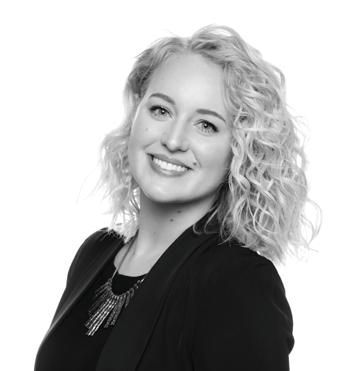


MA: Due to the pandemic, we shifted our business to an award-winning initiative titled ‘Meet well. Meet safe,’ which addresses reducing risk and the safety of hosting meetings and events in a post-pandemic world. Our team devoted a large amount of time and resources to ensure our clients didn’t miss a beat in serving their communities and clientele. As the world recovers and more and more companies are shifting back to in-person, our clients are leaning on us to do it the right way, which has made our business stronger than ever.
ME: One of the lessons drawn from the pandemic is efficiency. Do we need to conduct business in person when virtual meetings will suffice? The pandemic forced our organization to prioritize which travel is necessary. Sales certainly rise to the top. After all the recovery in the travel and hospitality industry these past two years, business travel is one area that has failed to bounce back. We see that in the local hotel occupancy rates between Monday through Thursday. The irony is not lost on us that we lament the loss of business travel to Council Bluffs, but aren’t doing more ourselves.
B2B
Legacy businesses play a vital role in Nebraska’s economy, providing stability and financial identity to our communities, as well as serving as a positive cultural force. “The Good Life” state is home to approximately two dozen companies that have beaten high odds to survive for more than a century Renze, Physicians Mutual, Union Bank & Trust, and HDR among them and so many others that are 50+ years old. A considerable number of those legacy firms are multigenerational or employee-owned. The businesses on the following pages are proud of their longevity and tradition, and appreciative of the decades of patronage and support. Read on to learn their stories.
Note: This sponsored list reflects a portion of the companies in Omaha that are eligible to claim legacy status.
B2B
Omaha Magazine is proud and grateful to be celebrating its 40th anniversary as Omaha’s premier source of local, people-driven journalism.
It’s about the community at large the artists, the businesspeople, the philanthropists, the families, and everyone that calls Omaha home. Omaha Magazine publisher Todd Lemke truly believes in this representation, which is why he made the company motto, “It’s About All of Us.”

The magazine celebrates 40 years of production in 2023. Two years after graduating from the University of Nebraska–Lincoln with a degree in journalism, Lemke entered the local media sphere with the publication of a magazine called Omaha Today and hasn’t looked back since.
In 1987, Lemke purchased a monthly titled Our City, which listed local places to shop, eat, and be entertained an ideal publication to acquaint visitors with Omaha that quickly became a staple in hotels throughout the metro.
There has been an Omaha Magazine in the area since 1890, but in 1989 the registration on the name lapsed, and Lemke seized the opportunity to grab the title while merging his two publications under one banner.
“We are a paid/requested mailed publication that spans all ages and economic brackets,” Lemke explained. “What binds our reader is the connection with, and love for, Omaha.”
According to a recent audit, education level is another defining factor regardless of age.
“We are a read, not a flip. We’re a rare combination of informative, entertaining material, and great photography. Because of that, we have a highly educated reader,” Lemke continued.
“79% of our readers attended college, with 97% fairly evenly spread between 25 and 74 years of age between print and digital flip books, nearly 220,000 readers enjoy Omaha Magazine per issue.”
Along the way, the family-owned company has retained a family-friendly atmosphere. At least four employees have held the Lemke surname brother Tyler, niece Sarah, nephew Alex, and Todd’s mother, Gwen. Many children of its staff members have held summer jobs or internships over the years, with some even becoming full-time employees.
Omaha firefighter Greg Eckstrom remembers his 2005 editorial internship fondly:
“I really enjoyed my internship there and everyone that worked at O Mag...I learned a lot,” Eckstrom recalled. “I accidentally fell into firefighting through journalism, so I still do a bit of writing on the side I was a small-town newspaper editor and in trying to find the best ways to get news leads, I joined the local volunteer fire department and ended up switching fields entirely!
I ran our union’s local magazine for a couple years. I still help out with our department’s fire history magazine a bit. And like every recovering journalist, I’m trying to get a book out of me and on paper!
“I still read Omaha Magazine,” he added. “You guys have consistently put out a fantastic publication for longer than most national magazines have even existed! Keep up the great work!”
Today, nearly 20 employees adhere to the company’s core values of community, respect, passion, integrity, creativity, and excellence driven by the desire to tell the best stories Omaha has to offer.
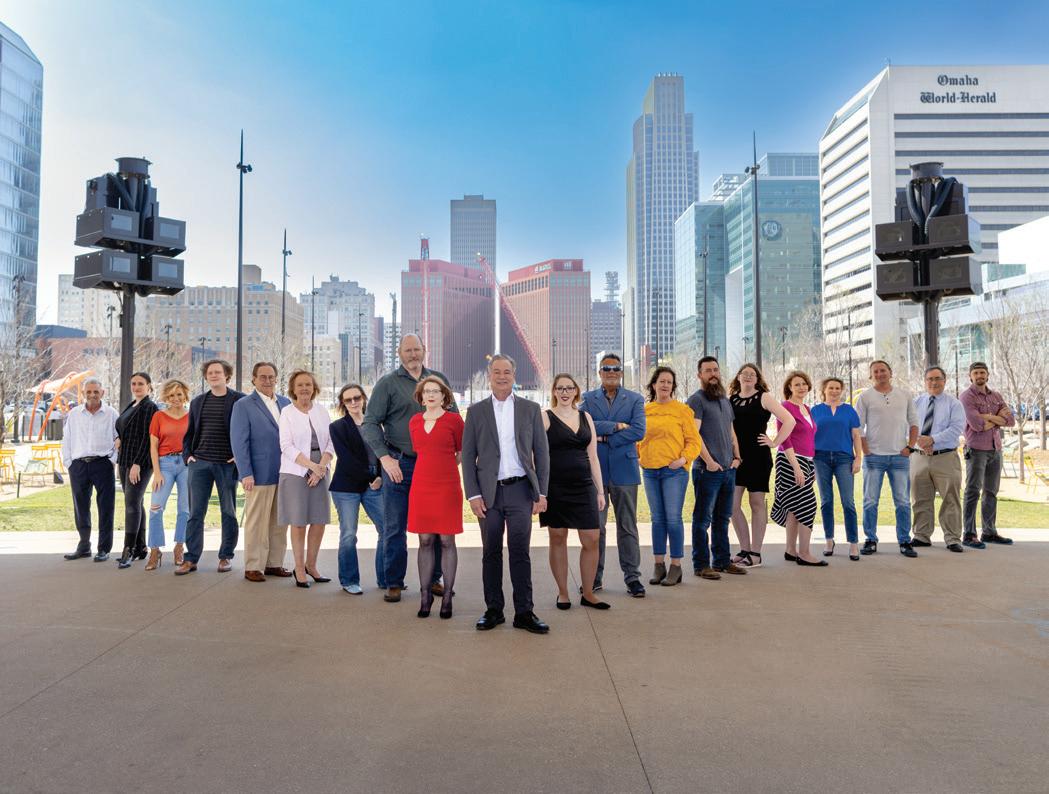
The magazine has earned numerous accolades, including the 2017 ‘Magazine Photographer of the Year’ award, won by photographer Bill
Sitzmann, and the coveted ‘Magazine of the Year’ award in 2018 from Tulsa’s regional Great Plains Journalism Awards under the direction of then-executive editor Doug Meigs. More recently, managing editor Julius Fredrick won Great Plains’ 2020 award for ‘Lifestyle Writing’ for his piece on Omaha’s Japanese sister city, “From Shizuoka with Love,” and creative director Matt Wieczorek, along with Sitzmann and Sarah Lemke, brought home the ‘Magazine Cover’ award for “A Fatal Cut: The Human Cost of Omaha’s Fentanyl Flood” in 2023.
“But Omaha Magazine isn’t complacent with its past successes, we’re always looking toward the future,” Lemke noted.
While print remains at the heart of Omaha Publications, the company continues to evolve with the times, offering a suite of both traditional and digital options for savvy advertisers, including:
a robust and engaged web audience, sizable email lists, custom publications, and targeted programmatic campaigns. And earlier this year, Omaha Magazine began partnering with Radio Talking Book Service to provide audio versions of our stories. To listen, click on the link on the online table of contents page.
“Recently, we launched Omaha Content Studio, which rolled out book publishing,” Lemke announced, marking yet another exciting pivot for Omaha Magazine. “My professional motto is: ‘Good, Better, Best; Never let it Rest.”
OMAHA MAGAZINE
5921 S. 118TH CIR.
OMAHA, NE 68137
402.884.2000
OMAHAMAGAZINE.COM
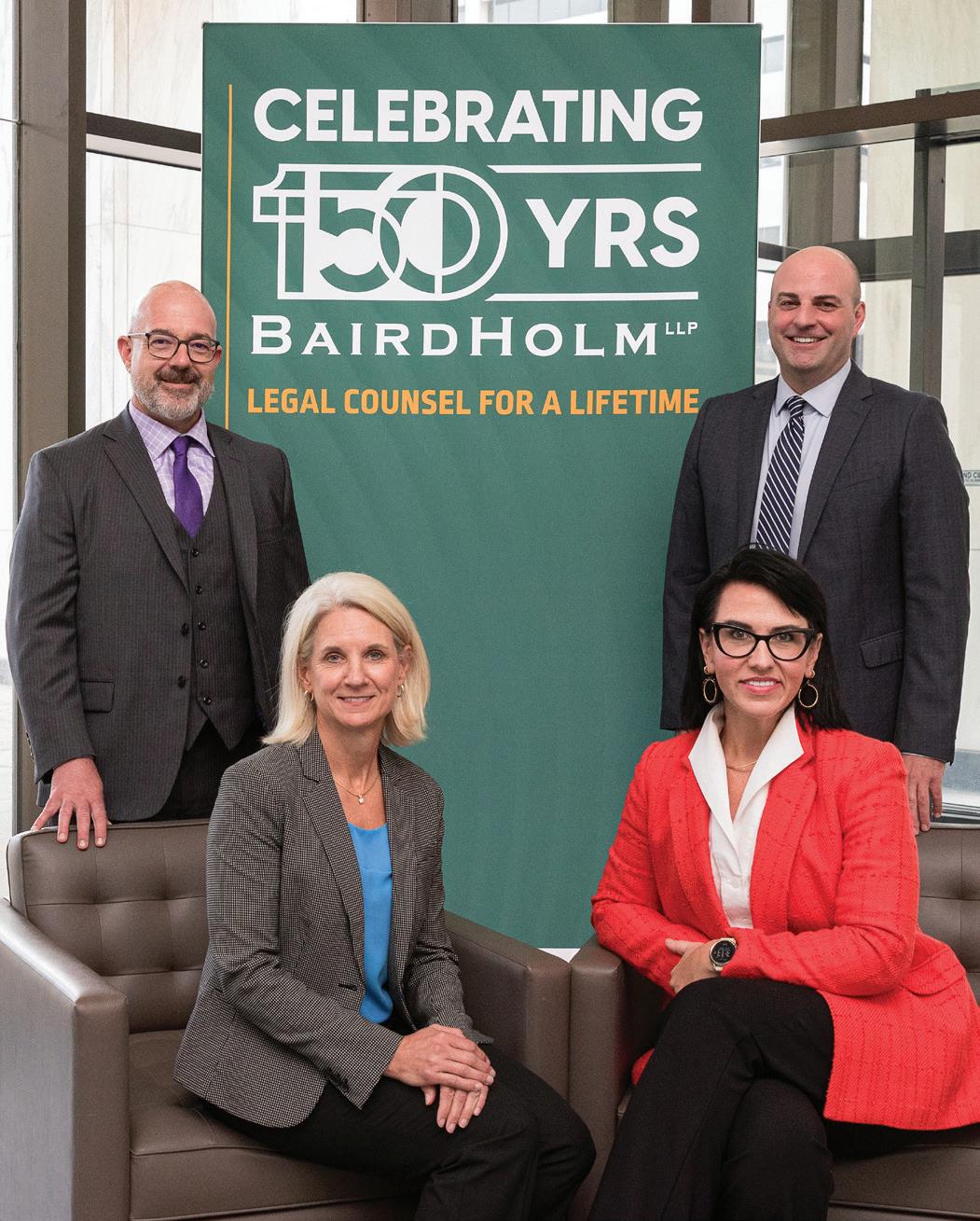
A few law firms in Omaha have reached the century mark, but only one can trace its origins to 150 years ago: Baird Holm. The firm is deeply intertwined with the city and state itself, playing a role in numerous milestone events including the Trans-Mississippi and International Exhibition hosted in Omaha in 1898 and the 1920 revision of the original 1867 Nebraska Constitution.
“Literally, we’re part of the history of the community,” Managing Partner Chris Hedican said.
Baird Holm’s own history begins with three law firms founded in 1873, 1878 and 1888. The 1970 incarnations of these firms merged to become today’s Baird Holm. The firm now has 97 attorneys licensed in 22 states, and it’s seen steady growth over a century and a half.
Although the fundamentals of the practice of law have remained the same, Baird Holm looks very different in 2023 than its originators’ firms looked in the late 19th century. Hedican has personally seen significant changes during his career, from computers replacing typewriters to the digitization of copious amounts of information.
In the late 1800s, the legal sector was dominated by Caucasian men, so another visible difference between then and now is the diverse makeup of the team, especially their female attorneys. “We are proud to have the highest percentage of female attorneys and partners among similar sized firms in the region and elsewhere; in fact, more than 1/3 of our attorneys are female. The firm is a founding member of the nonprofit Nebraska Legal Diversity Council and recently received the Midsize Mansfield Certified Plus recognition.”
“I think the most significant development in the legal industry was that kinds of arcane views of who could be a lawyer have changed,” Hedican said.
Baird Holm’s work also represents clients of diverse backgrounds and communities, including public and private companies, individuals, private funds and other investors, financial institutions, governmental entities and nonprofit organizations.
The firm has also evolved with the times in other important ways, he added.
“As a firm, we’ve been very good about anticipating and responding to developments within the marketplace in terms of the needs for legal services. We’ve developed new practice areas, regularly, that didn’t exist at one point in history, either in Omaha or anywhere. That’s been a big part of our ability to endure,” Hedican said. “For example, 20 years ago you didn’t have renewable energy practice. Now we have the best one around. Twenty-five years ago, we had one employment attorney and now we have the largest employment practice in the area. We have a fair housing practice that didn’t exist before, we have a tax increment financing department that didn’t exist before.” “Lawyers in our firm helped found the American Health Care Association.”
During the COVID-19 pandemic, Baird Holm provided guidance to many companies and health care institutions, Hedican said.
“We advised businesses and employers on various compliance issues, employee health and remote work, navigating PPP loans, amongst other issues, on a daily basis,” he said. “I’m proud that we were really an important resource for helping our clients through that difficult period of time.”
The firm has longstanding recognition in the legal sector. Baird Holm attorneys have been listed in Best Lawyers in America and as Super Lawyers, and have received the Peer Review Ratings AV certification mark by Martindale-Hubbell. The firm itself is the only one in Nebraska listed in the highest tier in the five main categories used by Chambers USA. Baird Holm attorneys have held
many leadership positions in industry associations including Nebraska State Bar Association, Omaha Bar Association, the local Barristers Club, Nebraska State Supreme Court’s Advisory Committee on Legal Ethics, Nebraska office of Mandatory Continuing Legal Education, and American Academy of Hospital Attorneys (now the American Health Lawyers Association).
The firm is also known for its involvement in the community, Hedican said, and recently introduced BH Community Works to provide additional opportunities for attorneys and staff to donate their time, expertise and financial support to area organizations.
“Our firm has always been very involved in community and philanthropic organizations. We encourage our attorneys to be on boards and we support those organizations financially,” he said. “BH Community Works is really just more of a formalization of (activities) that we’ve done before. But we’re driving it more proactively… It’s more thoughtful.”
“Baird Holm has attracted not only law school graduates into the firm, but also experienced attorneys formally associated with other firms or companies,” Hedican said.
“By my estimation, probably somewhere around a third of our firm has lateral origins,” he explained.
“We’ve been very proactive and responsive to developing legal practices, as the economy in the world has changed, and we’ve created a culture that attracts some of the very best lateral attorneys and then we integrate them well within the firm. And then I also think we’re just a really, really good place to work.”
BAIRD HOLM LLP
1700 FARNAM STREET, STE. 1500 OMAHA, NE 68102-2068
402.636.8259
MWILLIAMS@BAIRDHOLM.COM
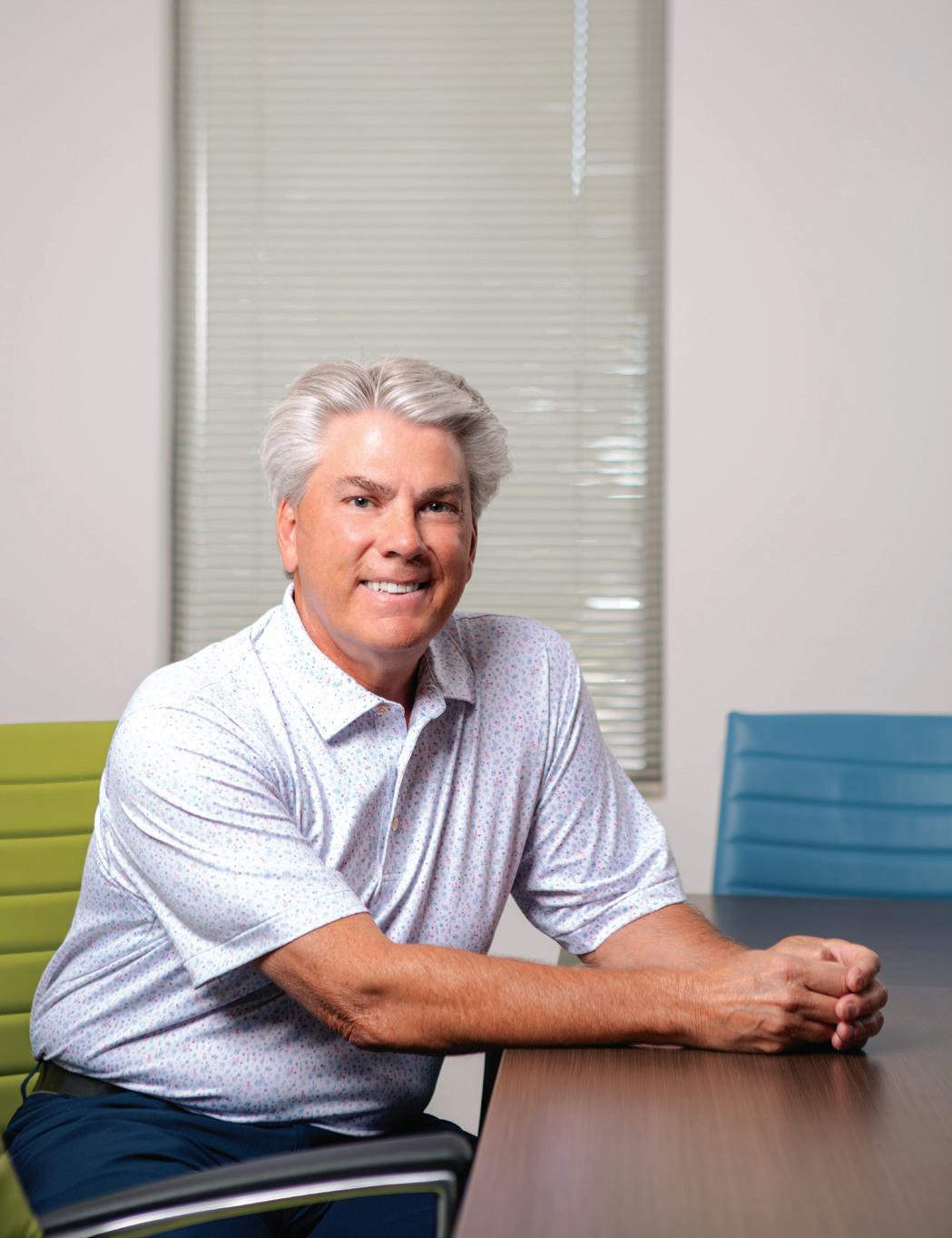 Mead Lumber Company
President Dave Anderson
FEATURE | STORY BY DWAIN HEBDA | PHOTO BY SARAH LEMKE
Mead Lumber Company
President Dave Anderson
FEATURE | STORY BY DWAIN HEBDA | PHOTO BY SARAH LEMKE
Jay Stewart, CEO of Drake-Williams Steel, has seen a lot of change in his 33 years with the company. Technology, training protocols for employees, and market shifts have all come and gone during his career.
One change, however the company’s shift to 100% employee ownership in October 2014 is as reflective of the past as it is forward-looking. John and Dave Williams, fourth-generation owners, made the decision to implement an employee stock ownership plan (ESOP) as a lasting embodiment of the high regard in which ownership had always held its 300 employees.
“The family owners had a strong desire to see the company end up in the employees’ hands in some form or another,” Stewart said. “And they had made a conscious decision to explore those options and to move down that path many years before that. We explored a variety of paths there; we looked at a management buyout, we looked at other forms of employee ownership, and we settled in on ESOP.”
Across the country, companies of all shapes and sizes are taking similar steps to transfer ownership of companies from private hands to that of employees. ESOPs are basically an employee retirement benefit whereby shares of company stock are allocated to all employees and governed by some of the same laws and regulations as 401(k) plans. Unlike 401(k)s, however, employee stock is almost always issued at no cost to employees, making them more attractive than other retirement benefits that require employee contributions.
According to The ESOP Association based in Washington, DC, there are more than 6,500 ESOP companies representing more than 10.6 million employee owners coast to coast. Industries with the highest number of ESOP companies represent a varied cross-section of the business world, including manufacturing, science, technology, real estate, finance, and insurance.
“Without a doubt there is a surge in new ESOP formations taking place across the country right now,” said Jim Bonham, president and CEO of The ESOP Association. “One, there have been a lot of changes in public policy recently, both at the federal and at the state level, to encourage more ESOP formation and more awareness of the benefits of selling your business to your employees.
business owners have no existing transition plan, so we’re doing a great deal of outreach and promotion of the employee stock ownership plan model to those retiring baby boomer business owners.”
In addition to providing a nice benefit for workers, local companies said ESOPs provide additional benefits overall, particularly when it comes to retaining employees.
“I think in terms of retention it is just a fantastic tool, for many reasons,” said Cathy Maddox, ownership coordinator with Commonwealth Electric Company of the Midwest, based in Lincoln. “When you are an employee-owner, you have some skin in the game. This is your company. What you see every year on your statement is in large part a direct result of how you’ve done your job. Have you done it efficiently? Have you done it effectively?”
Commonwealth Electric phased in its ESOP from 60% ownership among eligible employees when the plan was introduced in 2017 to 100% three years later. Maddox, who handles the ESOP program full time, said such programs also benefit the community at large.
-JIM BONHAM“Second, over the next 10 years there are about 2.8 million business owners who are baby boomers who will need to retire and do something with their business upon their retirement. This will actually be the single largest transfer of wealth-producing assets in the history of the world. About 65 percent of those
“There are so many businesses that are either going to go out of business, which means jobs lost, or are being bought by a bigger corporation, which could mean jobs being moved elsewhere,” she said. “If those companies can become employee-owned that helps ensure those jobs stay in place and that’s advantageous to an entire community.”
“OVER THE NEXT 10 YEARS THERE ARE ABOUT 2.8 MILLION BUSINESS OWNERS WHO ARE BABY BOOMERS WHO WILL NEED TO RETIRE AND DO SOMETHING WITH THEIR BUSINESS UPON THEIR RETIREMENT. ”
Dave Anderson, president and CEO of Mead Lumber Company, said education is the key to a successful ESOP program, especially early on in the process.
“It’s an ongoing challenge to explain everything about how ESOP works,” he said, noting the company has been 100% employee-owned since 2014. “People who have been here for a time get the concept. But still, when it comes close to retirement, they have questions about how distributions work and how they get their money out.
“As for newer workers, it probably takes three to four years for frontline, operational employees to understand it. So, we spend a lot of time on the educational side of it.”

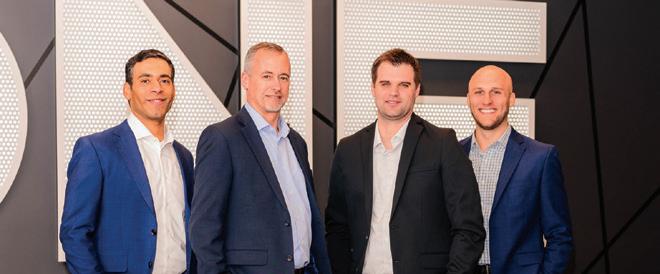
Speaking anecdotally, Anderson said having such a program can result in better employee engagement as people look at their work as an owner would, boosting efficiency, safe behaviors, and innovative thinking.


“I think the dedication level is higher within the ESOP structure because they see the tangible way that they’re benefitting from the decisions that they make,” he said. “And that’s an item that we spend a lot of time from the education standpoint depending on your position, what are the decisions you’re making every day that either add value or subtract value. ESOP is absolutely a positive influencer and it’s great for the culture of our company.”
For more information, visit esopassociation. org/chapters/iowa-nebraska; dwsteel.com; commonwealthelectric.com; and meadcompanies.com.
B2B

“I THINK THE DEDICATION LEVEL IS HIGHER WITHIN THE ESOP STRUCTURE BECAUSE THEY SEE THE TANGIBLE WAY THAT THEY’RE BENEFITTING FROM THE DECISIONS THAT THEY MAKE.”
-DAVE ANDERSON
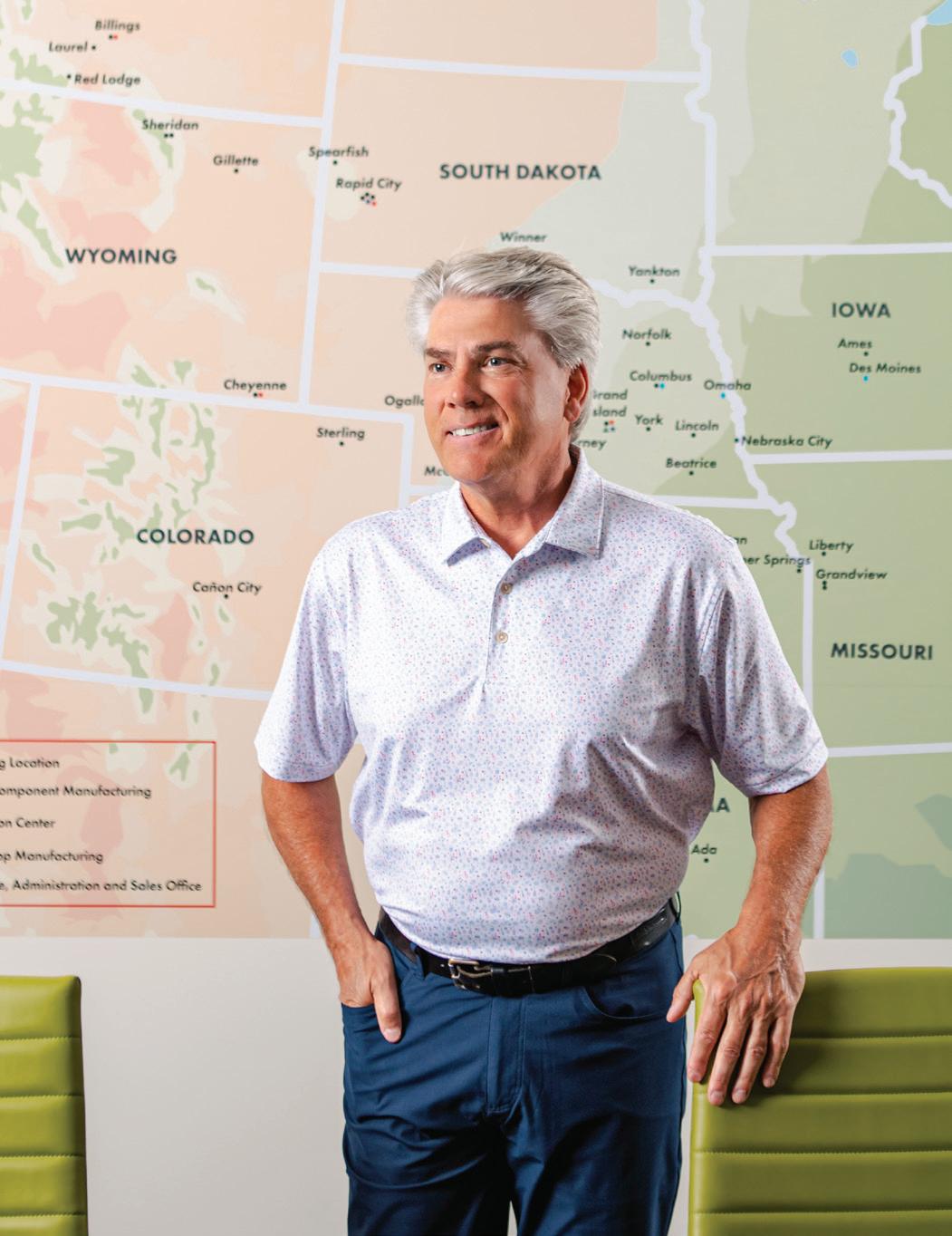 FEATURE | STORY BY LEO ADAM BIGA | PHOTO BY BILL SITZMANN
FEATURE | STORY BY LEO ADAM BIGA | PHOTO BY BILL SITZMANN
Studies show only 3% of family-owned businesses reach four generations. That puts 105-year-old All Makes Office Furniture and Technology in rare company. Running things today are siblings Jeff Kavich, president/CEO, and Amee Zetzman, executive vice president and CFO. They joined their late father, Larry Kavich, and grandfather, Lazier Kavich, in the company in the early 1990s, learning the ropes from the masters of the deal.
Founder Harry Ferer, a Russian immigrant, began with a typewriter sales, rental, and repair firm in 1914 before opening All Makes in 1918. Son-in-law Lazier entered the business in 1938, adding office furniture and machines to an inventory keeping pace with evolving business-office demands. In 1962 All Makes moved from its original 1918 Farnam Street location to its current 2558 Farnam site in the former Rosen Novak Chevrolet dealership building. Larry came on that same year, adding contract furniture and eventually new locations in Lincoln and Des Moines.
Four generations represent “a lot of history,” Amee said. “It really speaks to our endurance, honesty, and pledge that we do what we say we’re going to do. Jeff and I always use the phrase, ‘Let us tell you what we can do, not what we can’t.’”
Added Jeff: “We often share [with customers and business partners] the fact we’re four generations strong because we feel it’s important and meaningful.”
Amee finds the dwindling number of locally owned and operated multi-generation family businesses “unfortuneate.” As that group gets smaller,” she said, “it’s just a different environment.”
When franchises replace family firms, personal relationships get lost in the process, she warned.
All Makes’ resilience is due, Jeff said, to his grandfather and father “handing Amee and me a healthy business.” During their own tenure, the siblings have added stores in Columbus, Kearney, and North Platte. “The impetus,” Amee said, “was to serve clients better in northeast, central, and western Nebraska by having industry experts in those markets.” Brother and sister have also added the company’s own private label line, the Farnam Collection, and a digital document management/ technology division.
Still only in their mid-50s, these business leaders anticipate growing things more as new needs and opportunities arise. They’re grateful for having “defied the odds” by shepherding the business into a fourth generation, one marked by a recession and pandemic. They attribute their ability to avoid the fatal pitfalls that doom most family businesses to values and principles instilled in them by their father.
“The ultimate lesson from our dad was, ‘Yes, you two are going to run the business, but your first priority is to each other as brother and sister.’ That was critical,” Amee said, adding, “We have each others’ backs.”
The pair confirmed the All Makes’ culture is family-based.
“That is, in fact, how we feel and how we go about it,” Jeff said. “That contributes to the average length of tenure here being 11 years. People come to work at All Makes and they stay, and I think they stay because we create a very nice work environment.”
Because both he and Amee were exposed to the business as kids, they grew up around veteran staffers. “We’ve known so many of them for so long,” Jeff said.
“They are part of our extended family. It’s very comforting” having ample “institutional knowledge” to lean into,” Amee added.
This brother and sister act successfully work together by staying in their lanes and playing to each other’s strengths.
“I think very critically about what’s next, and Jeff is very client service-oriented,” Amee said. “He’s thinking of it from what the client wants and I’m thinking of the mechanics of how to get it done.”
“Amee is more objective, and I’m more subjective,” Jeff observed. “We talk openly about what we both do. There are times when we get into conflict over something, but we have always been taught don’t take it home with you; it’s business, figure it out. We’re blessed in that we can talk things through.”
Successfully adapting to a more nuanced office world has kept All Makes competitive.
“THE ULTIMATE LESSON FROM OUR DAD WAS, ‘YES, YOU TWO ARE GOING TO RUN THE BUSINESS, BUT YOUR FIRST PRIORITY IS TO EACH OTHER AS BROTHER AND SISTER.’ THAT WAS CRITICAL. WE HAVE EACH OTHERS’ BACKS.”
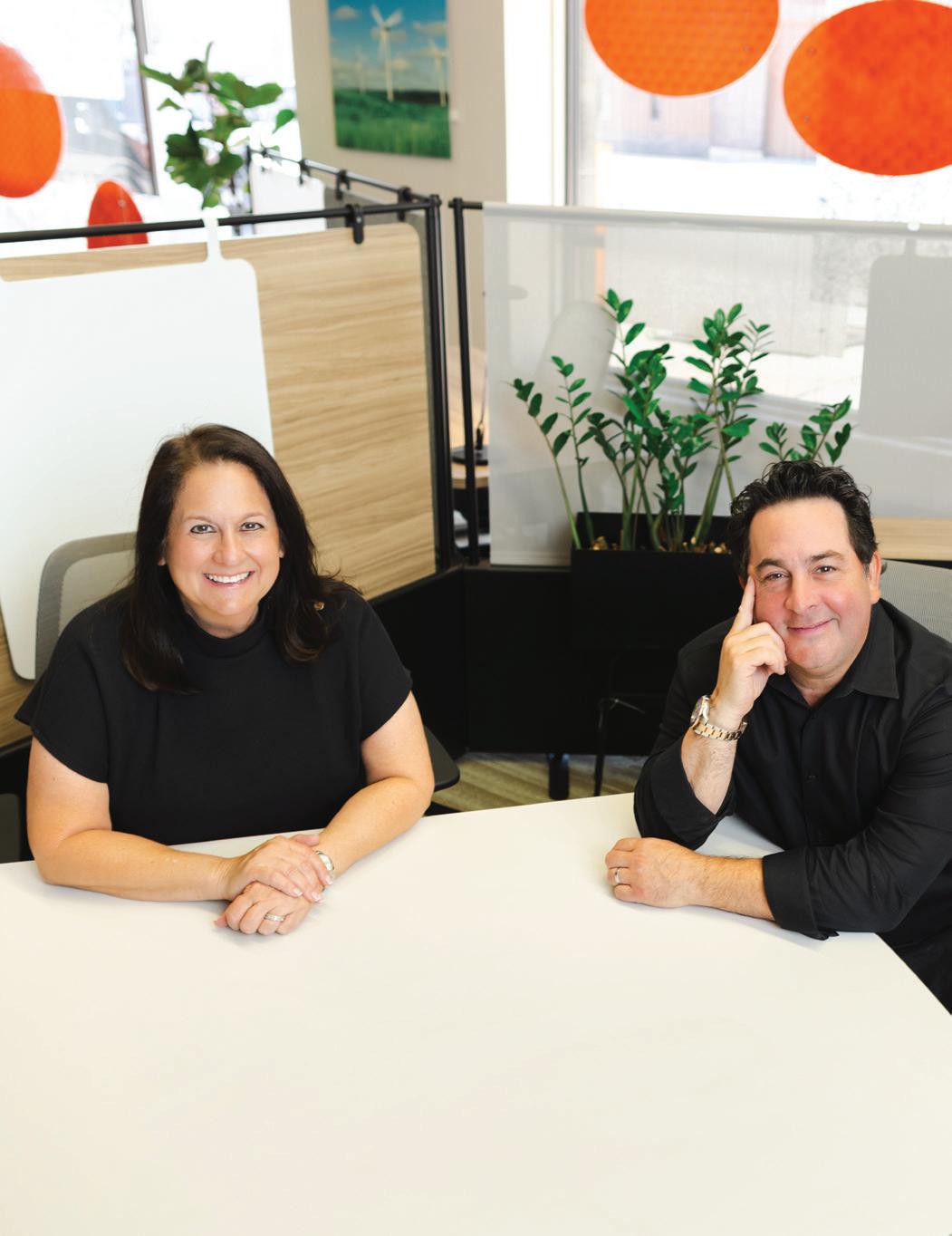 -AMEE ZETZMAN
-AMEE ZETZMAN
FROM PAGE 28
“The sell has gotten far more complicated,” Jeff explained. “Everything we do today goes through the design department. There’s soft seating, sound masking, and collaborative work spaces. When I came in, desks came in two sizes and three finishes. Chairs came in six different fabrics. We stocked all that product in the warehouse. It was a quick, easy transaction. Today, it can take months.”
“People want it to look a certain way and to be super functional and flexible,” Amee expanded, “and to make that happen requires design knowledge.”
A changing work culture means hybrid work stations that maximize comfort, adjustability, and health.
All Makes’ major client base is spread over a large swath of Nebraska, Iowa, and the greater Midwest. They have national and international customers as well.


Aside from some supply-side issues, the pandemic had little effect on the business.
The Farnam flagship store is in a destination district with new development and anchor attractions. Omaha’s planned streetcar will pass right by its front door. Newly remodeled showrooms are a sure sign of the company’s investment there.


“Our team will utilize four different ways to work, which makes a great way for people designing new space to visualize the differences,” Amee said.



Jeff fully expects new office trends to emerge, adding, “We’ll be ready for it when it happens.”
With no fifth generation in the wings, the siblings are the last in their family line at the helm. As for what happens to the business when they decide to step down, Amee said, “To be determined. But we have endured for this long, and we will figure out the best scenario for the company.”


Visit allmakes.com for more information.



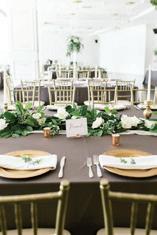




B2B



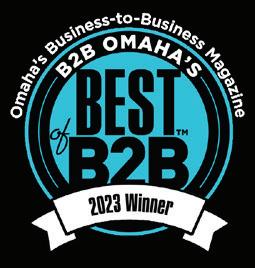

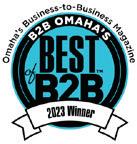

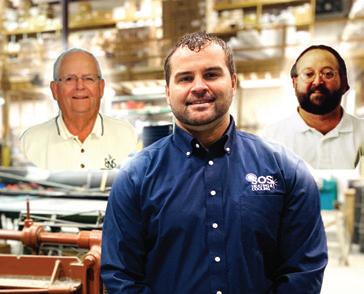

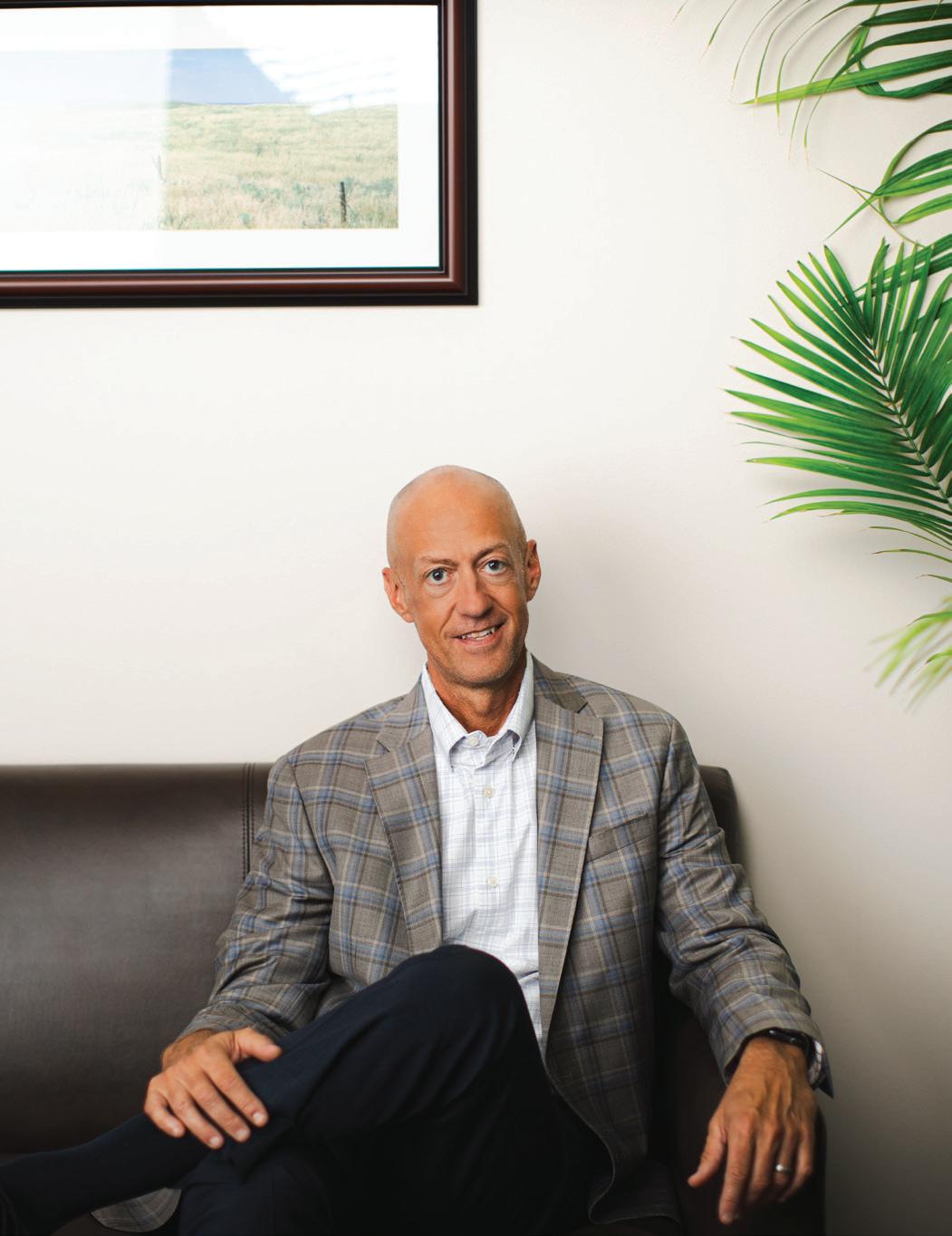 Platte Institute CEO Jim Vokal
FEATURE | STORY BY KIM CARPENTER | PHOTO BY BILL SITZMANN
Platte Institute CEO Jim Vokal
FEATURE | STORY BY KIM CARPENTER | PHOTO BY BILL SITZMANN
If you’re daydreaming of retiring to traditional havens like Florida, Arizona, and Nevada, here’s a one-word retort: Nebraska.” That was Paul Davidson’s snappy opener for his July 10, 2019, USA Today article titled “Sorry, Florida and Nevada: This state ranks as the best for retirement.” The piece was in response to Bankrate.com’s annual ranking of the nation’s best states to live out your golden years. According to the rubrics of affordability, wellness, weather, culture, and crime (in that order), Nebraska came out on top.
The problem? Nebraska’s retirees don’t seem to agree. Forget the much-ballyhooed “Brain Drain” of Nebraskans in their 20s leaving the state. Retirees aged 55-70 are also packing moving boxes and taking their tax dollars and spending power with them. They make up Nebraska’s “Gray Drain,” and the cost to Nebraskans entails more than just a financial loss.
What accounts for this “out-migration” of graying tax payers? Experts often cite how individual states approach retirement income. Florida, Nevada, Washington, Tennessee, Texas, South Dakota, Wyoming, and Alaska don’t tax retirement income at all, whereas other states don’t tax Social Security benefits or they implement tax credits and/or exemptions to assist retirees. Only 11 states currently tax Social Security, including Colorado, Connecticut, Kansas, Minnesota, Missouri, Montana, New Mexico, Rhode Island, Utah, Vermont, and Nebraska.
Jim Vokal chief executive officer for the Platte Institute, which advances policies that remove barriers to growth and opportunity in
Nebraska laments the state’s lack of incentives for senior citizens. “I hear constantly from retirees who say, ‘I just can’t afford to live here.’ I think it’s largely, if not mostly, based on our uncompetitive tax situation compared with that in other states.”
That will soon change, as Nebraska will be off the list of states that tax Social Security. On May 31, Governor Jim Pillen signed tax reform legislation that he labeled “transformational” for Nebraskans. In addition to reducing individual and business income tax rates to 3.99% by tax year 2027 and providing tax credits related to childcare, LB754 accelerates tax exemption for Social Security benefits, which will go into full effect in 2024.
While this legislation is a step in the right direction, Vokal cited other concerns, such as estate planning. “We’re one of five states [alongside Maryland, New Jersey, Pennsylvania, and Kentucky] with an inheritance tax. It’s on the mind of seniors, who want to pass on their assets. [It used to be six: Iowa repealed its inheritance tax in 2021 and is phasing inheritance taxes, with the last inheritors paying a reduced rate through 2024.] These folks have tremendous financial options, even in states that are cool during winter like Nebraska. We lose retirees to North Dakota, Missouri, Kansas, and Iowa the list goes on. It’s a cumulative effect.”
David Drozd, director of research and data analysis at Community Health Development Partners, knows about those cumulative effects. The demographer conducted an exhaustive study on Nebraska’s migration for the University of Nebraska at Omaha’s Center for Public Affairs Research in 2020. While that analysis focused on Brain Drain, it also indicated the impact of retirees leaving the state.
“NEBRASKA HAS STRUGGLED WITH OUT-MIGRATION FOR A LONG PERIOD OF TIME. WHAT I FIND WITH NEBRASKA’S OLDER POPULATION AND THEIR OUT-MIGRATION IS THAT IT’S VERY CONSISTENT. FOR AGES 55 TO 74, IT HAS OCCURRED EACH OF THE PAST 12 YEARS AVERAGING 800 PEOPLE ANNUALLY. THAT DOESN’T SOUND LIKE MUCH, BUT OVER A DOZEN YEARS, THAT’S ALMOST 10,000 PEOPLE.”
-DAVID DROZD“Nebraska has struggled with out-migration for a long period of time,” Drozd said. “What I find with Nebraska’s older population and their outmigration is that it’s very consistent. For ages 55 to 74, it has occurred each of the past 12 years averaging 800 people annually. That doesn’t sound like much, but over a dozen years, that’s almost 10,000 people.”
Noting that this is the first data point, Drozd continued by citing retirees who leave other states. “We are only the 35th best in terms of senior migration. We’re similar to Kansas, which is 36th. That is in comparison to other states with bad weather and high taxes who rank at the bottom, like New York, Connecticut, New Jersey, and Illinois. And Nebraska consistently loses people to the coldwinter states South Dakota and Wyoming, which have no state income tax.” CONT.



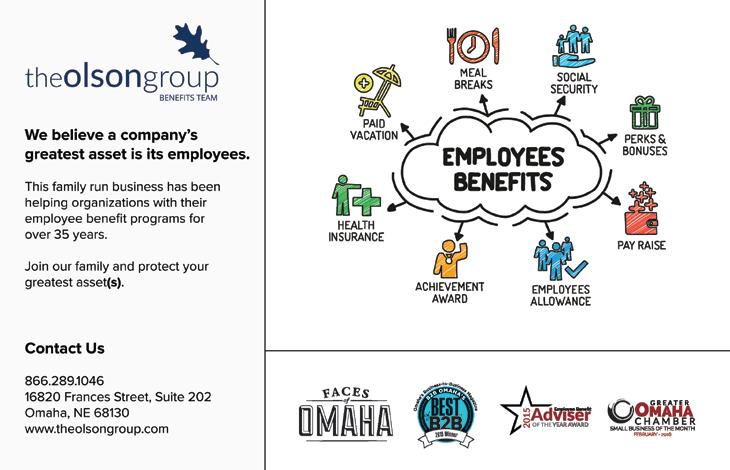
Yet another critical data point: Gray Drain’s financial impact. “Say the average income is $50,000,” Drozd posited. “If the state income tax rate is 5%, that’s $2 million a year in lost Nebraska state tax revenue. That’s $24 million over 12 years in simple math. Accounting for the aggregate impact of that income not being taxed in Nebraska year after year once people leave, it’s $153 million over 12 years.”
John worked in the insurance industry until 2013) now makes their home in Estes Park, Colorado. The Naughtons purchased their cabin in 1990 as a summer retreat and eventually remodeled it for winter living. They sold what they fondly called their “big family home” in 2014 and made the move from Omaha to Colorado.
“I just love the mountains,” Phoebe confessed. “It’s where we wanted to retire. It wasn’t really about the cost.”
That isn’t to say that the Naughtons don’t track their monthly expenses. John is quick to point out the difference between the two states. “On balance the higher cost of living evens out the lower taxes in Colorado,” he said. “The cost of gas and daily transportation can be very expensive. Food in grocery stores is taxed. There are other pieces to the puzzle outside the tax structure.”
But we need to be more competitive. The reason why this is so important is the leading edge of baby boomers are now hitting 75. The tail end will hit 65 for the next 10 years. The potential loss is a large social and financial impact.”
Michael Lucci, senior policy advisor at the Platte Institute, is similarly concerned. “Baby boomers have half the nation’s wealth. They’ve been saving their whole lives. We do not want their spending and investment power out of the state.”
Meanwhile, retirees like the Kellys and the Naughtons continue coming “home” to Nebraska, at least for extended stays, dividing their golden years between Ohio and Colorado, respectively, and Omaha, where they’ve spent the majority of their lives.
“The loss to Nebraska and its citizens is great,” Vokal concurred. “There is a correlation between out migration and the loss of income to the state. It puts more pressure on everyone else to fund the government. Another less-tangible cost is the one to the community. There is an impact on the family not having elders around to experience life’s monumental moments. I can’t imagine my kids not having their grandparents around.”
Although that aspect is less quantifiable, Drozd said. “It’s not just dollars and cents. These folks, especially if they have a bachelor’s degree, are more likely to be civically engaged in clubs and as volunteers and to have leadership roles. We don’t just lose their spending power, but intangibles to the community.”
But are taxes the main driver behind Nebraska’s Gray Drain? Not necessarily.
“It’s not just the finances,” said Nick Shannon, a retirement planning financial advisor and founder of Prestige Wealth. “Climate and family dynamics are big components in determining primary residence. Family plays, I would argue, an even more important role, and Nebraska is very family friendly although we can’t completely ignore finances.”
Phoebe and John Naughton, both 75, are a prime example of Nebraska’s Gray Drain. The couple (Phoebe retired from education in 2007, whereas
In that respect, Nebraska places above other states. Depending on the source, the cost of living in the state is between 5% to 8% below the national average, a savings that adds up over time.
As Shannon indicated, another major driver behind the Gray Drain is family, and the proximity of both children and grandchildren.
Mike Kelly, 74, was a reporter and columnist for the Omaha World-Herald for almost 50 years before retiring in 2018. He and his wife, Barbara, then relocated to Cincinnati, Ohio, where both have family, including two of their four children and six of their 11 grandchildren.
“We did not think at all in terms of financial or tax reasons,” he said. “It was about family.”
Of course, moving to be near children is inextricably linked to the Brain Drain. If people in their 20s leave the state for career opportunities and lifestyle and cultural reasons, and family remains a chief reason for retirees’ relocating, getting rid of taxes on Social Security payments may not be enough to entice them to remain in the Cornhusker state.
“When it comes down to family, there’s a risk of Nebraska’s Brain Drain,” Drozd explained. “Seniors want to be near their grandchildren. Phasing out taxes on Social Security will help anything helps.
The Naughtons, while cherishing their time in Colorado’s mountains, rent a small home in Omaha from September 1 through May 31 every year. “For a while, we had a lot of little grandkids here,” John said, noting that even though those families eventually moved out of state, he and Phoebe continue to renew their Omaha lease. “I’ve had Creighton basketball tickets since 1966,” he chuckled, “plus all our friends and acquaintances still live in Omaha.”
That sense of belonging, kinship, and community is key.
“I’m very grateful to spend time here because I love and am very attached to Omaha,” said Kelly, who visits the metro about six times a year and remains registered with Sacred Heart Catholic Church. “This is where I know people. I still consider Omaha home.”
Shannon isn’t surprised that retirees like Kelly and the Naughtons divvy up their residential time. “Sometimes it’s about identity. People spend their lives and careers here and have community. It’s important to build in flexibility to be able to visit or vacation where you want.”
For more information, visit platteinstitute.org; cpar. unomaha.edu; and prestigewealthne.com.
B2B
“THE LOSS TO NEBRASKA AND ITS CITIZENS IS GREAT. THERE IS A CORRELATION BETWEEN OUT-MIGRATION AND THE LOSS OF INCOME TO THE STATE. IT PUTS MORE PRESSURE ON EVERYONE ELSE TO FUND THE GOVERNMENT. ANOTHER LESS-TANGIBLE COST IS THE ONE TO THE COMMUNITY.”
-JIM VOKALFEATURE | STORY BY KARA SCHWEISS | PHOTOS BY BILL SITZMANN
Anyone can pick up seeds or bedding plants; tools and implements; fertilizer, pesticides, and other products from a home improvement or general merchandise retailer. DIY landscaping or gardening is far more likely to succeed, however, with a little support from the savvy and experienced staff at a longstanding nursery or garden center.
“Our team of people has always been a strong point for us and gives us an advantage over the box stores,” Indian Creek Nursery’s owner, Scott Farrington, said of the business that’s been locally owned since its founding in 1966. “We provide knowledge, assistance, and service that are not available from a large store that focuses on many things besides plants and home decor…We try to ask questions of the customer (like), How much light? What side of the house? Things of that nature. Then we try to establish the proper location for plants or the proper soil and conditions for a vegetable garden. We try to work one-on-one with the customers when they’re here.”
“We are invested in our customers,” said Amy Wenninghoff, co-owner with her husband, Paul, of Wenninghoff’s, a fourth-generation retail family farm that began in 1956 in northwest Omaha. “They become like family, and we want them to succeed… The owners of our business are always seen and available for customers to give us feedback directly.”
Wenninghoff added that she and her staff are seeing more families grow gardens and involving their children, a trend that started when people were homebound during the pandemic.
“[Gardening] is an important life skill and hobby to teach,” she said. “We love being part of that. We have increased our vegetable plant production and we are always asked growing advice now.”
Mulhall’s is another local garden center emphasizing a personal touch, said CEO Mick Mulhall, with staff who can provide guidance to help customers’ gardens and landscaping thrive. The family business was founded as Mulhall’s Landscaping & Lawn Service in the 1950s by his Irish immigrant grandparents, John and Maureen Mulhall. They originally operated out of their garage, but today Mulhall’s occupies a large property at 120th and Maple streets with recent improvements and renovations centered around a top-notch customer experience.
Horticulture was a passion of John Mulhall’s, said his grandson. The elder Mulhall grandfather not only earned a degree in botany; he was raised on a farm, worked on a peat farm, and worked for a specialty nursery while in Ireland. He hailed from County Wicklow, often called the Garden of Ireland, or in Mick Mulhall’s words, “The greenest county in the greenest country in the world.”
John and Maureen Mulhall came to Omaha in 1953, where John worked with the Omaha Parks Department and Creighton University’s building and grounds department before starting his own business.
“Cultivating the beautiful” is still a company focus today, Mulhall said. “It’s about connecting people to nature.”
These local legacy enterprises have all developed a loyal customer base.
“In 1928, the Wenninghoff family purchased the property and the city grew around us,” Wenninghoff said. “We now have lots of customers that live close by, so they shop with us weekly. We are able to keep the produce out of the sun after harvest so it stays fresh much longer than setting up under a tent on a street corner.”
The four-generation family business keeps evolving, she added.
“We grow and sell lots of produce and flowering annuals, perennials, and vegetable plants,” Wenninghoff said. “As our family changed, the business changed. When the kids were small, the produce business was small, and we were open July, August, and September. As they became older and could drive tractors, we added the pumpkin patch in October. When they became teens, we needed a way to keep them ‘out of trouble,’ so we added greenhouses to keep them busy more months of the year. Now they all have children, and our youngest son wants to continue the business; we have started the transition and will see where his family takes the business.”
“WE ARE INVESTED IN OUR CUSTOMERS. THEY BECOME LIKE FAMILY AND WE WANT THEM TO SUCCEED.”
-AMY WENNINGHOFF
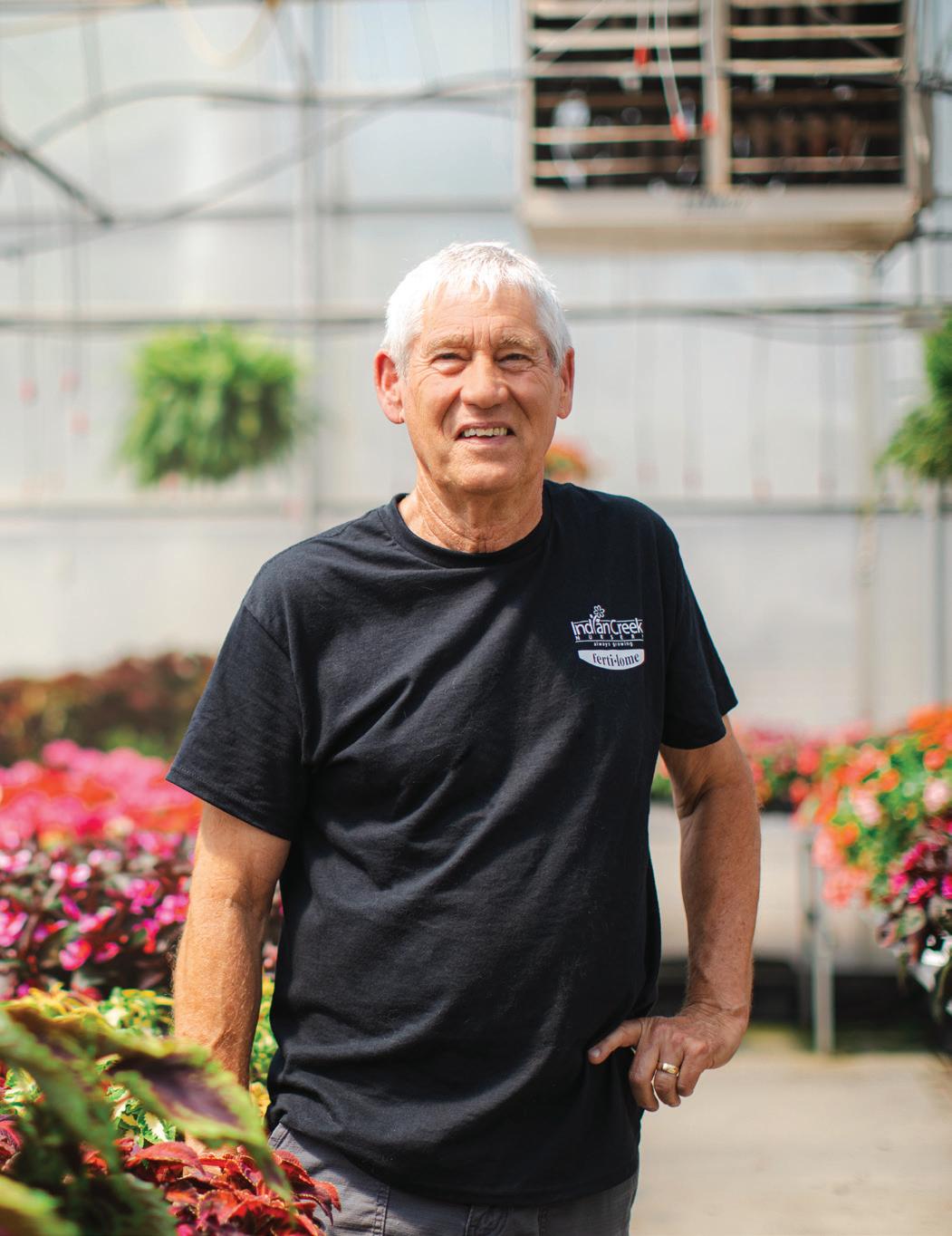 Indian Creek Nursery owner Scott Farrington
Indian Creek Nursery owner Scott Farrington
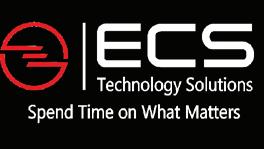




“We have always served and built our business with the neighborhoods around our store,” Farrington said. “Omaha is a great city for a business because we seem to be insulated from large economic downturns. Our location in the middle part of the city gives us many more homeowners per square mile than in the suburbs. We have never experienced large upturns in business that might happen in the new neighborhoods, but we also have not seen dramatic downturns. The recent trend has been the building of apartment buildings near and around our location. That has created a surprising demand for houseplants, pottery, and accessories.”
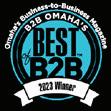

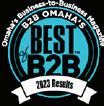

Indian Creek Nursery was originally located north of Council Bluffs and named for nearby Indian Creek. In 1966, Bill Farrington and Fred Schlott, landscape architects and designers, founded the company to cultivate a 20-acre tree farm for their projects. The business expanded into landscape plants and installation, and Scott Farrington began working there full-time in the early 1970s while attending college. At age 25, he began assuming the day-to-day management of the company after the untimely deaths of both founding partners.
Farrington opened Indian Creek Nursery’s Midtown Omaha garden center on Saddle Creek Road in 1981. Retailing has now become the prime focus of the company, he said.
“Indian Creek Nursery is a grower/retail garden center. We grow nearly all of our vegetables and herbs and a substantial part of our annual flowers and perennials on site. In addition, we always have a greenhouse full of houseplants along with pottery, soils, mulches, and a full complement of pest control solutions,” Farrington said. “Combined with our location in Midtown, this gives us a unique niche as a garden center. When we first opened, we were on a very tiny piece of property, but we still operated a tree farm and landscape company from Council Bluffs. Within a couple of years, the farm was closed and we began leasing some property from the city, south of our store. The area to the south grew in size and we began building greenhouses for production and sale of plants. Several years, ago a developer constructed commercial buildings on that land and we have ended up back on a much smaller spot, but very efficient and happy.”

As rewarding as the work is, the business has its challenges, Wenninghoff said.
“[It’s difficult] finding labor for the field work,” she explained. “It is hard manual work growing produce and not many people come knocking at our door to ask if they can sweat and get dirty every day with us. We tend to have a new crew every year in the field, so it is a lot of re-training on each task.”
Pandemic-initiated supply-chain challenges have also affected the company, Wenninghoff added, but her staff is finding solutions.
“We have done a much better job of asking our customers to return the empty trays, boxes, and containers that they purchase their plants with. We get to re-use them and they get to not throw them in the landfill,” she explained. “It’s a win for all of us.”
“The most difficult thing that I deal with is managing our team, purchasing, and finances in a seasonal business,” Farrington said. “Over one-third of our annual sales occur in May.”
The sector has been affected by consumer trends, Mulhall said, and some are very positive like integrating more robust native plants that require less water and are already acclimated to the local soil. Farrington said more customers are interested in organic products, ‘waterwise’ gardening and bringing pollinator-friendly plants to their yards. He and his staff, he added, are also willing to using their home gardens and landscaping as living labs to test out new ideas.
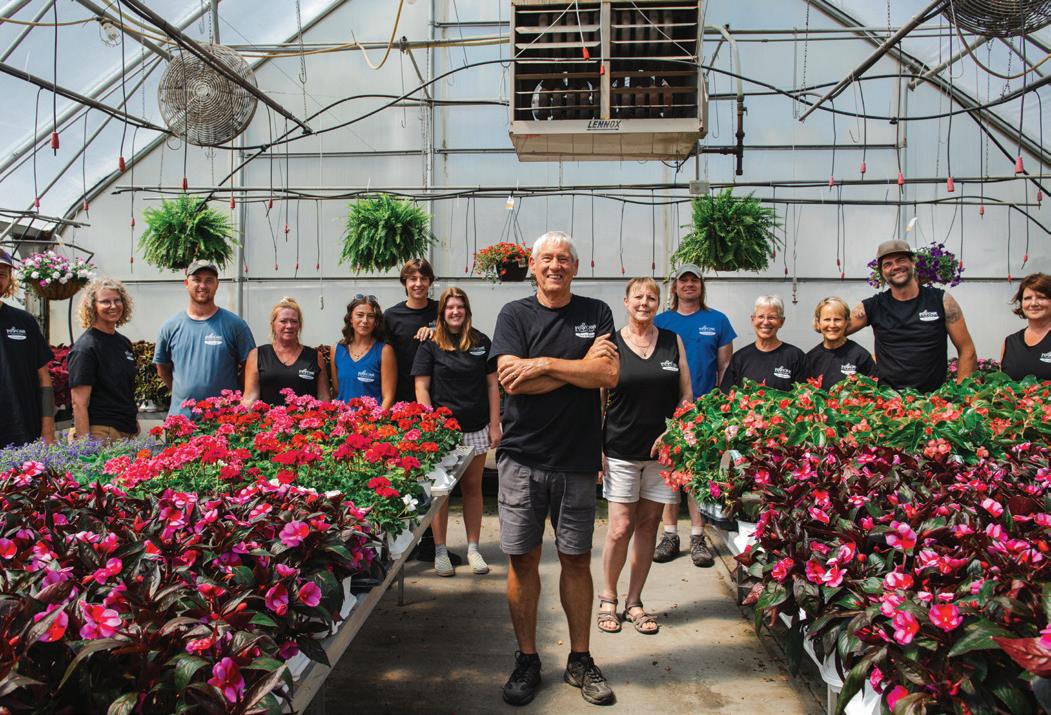
“Our team enjoys what they do; they enjoy helping people,” he said. “They like to deal with people’s questions and situations and really just love the customers that come in…It really is a lot of fun. It’s invigorating. And even though we deal with plants, and we’re really excited about plants, we’re really a people-friendly place.”
“MY HUSBAND HAS ALWAYS SAID HE WILL NEVER RETIRE—SPOKEN LIKE A TRUE FARMER. I HAVE TO ADMIT I THOUGHT HE WAS CRAZY, BUT NOW THAT I AM 60, I AGREE WITH HIM. WE HONESTLY LOVE WHAT WE DO AND CUSTOMERS HAVE BECOME FAMILY.”
-AMY WENNINGHOFF“My husband has always said he will never retire spoken like a true farmer,” Wenninghoff said. “I have to admit I thought he was crazy, but now that I am 60, I agree with him. We honestly love what we do and customers have become family. We couldn’t imagine not doing this.”
For more information, visit wenninghoff.com; mulhalls.com; and indiancreeknursery.com.
B2B
A record 18,456 votes were cast by the public in this year’s Omaha Metropolitan Area (OMA) Tourism Awards. This is the seventh year for the awards that recognize the best tourism businesses in Douglas, Sarpy, and Pottawattamie counties. Did your favorites win?
Douglas County
Best Attraction:
Winner: Gene Leahy Mall at The Riverfront
Runners-up: Junkstock and The Durham Museum
Best Hotel:
Winner: Hotel Deco
Runners-up: Omaha Marriott
Regency and Kimpton
Cottonwood Hotel
Best Restaurant:
Winner: Block 16
Runners-up: Monarch Prime and Upstream Brewing Company
Best Retail Business:
Winner: Borsheims
Runners-up: Nouvelle
Eve and Mangelsen’s Pottawattamie County
Best Attraction:
Winner: Dreamland Theatre
Runners-up: Prairie Crossing
Vineyard & Winery and
Hitchcock Nature Center
Best Hotel:
Winner: Ameristar Casino Hotel
Runners-up: Hilton Garden
Inn Council Bluffs and Country Inn & Suites
Best Restaurant:
Winner: The Back Forty Bar & Grill
Runners-up: Garcia’s
Family Mexican Restaurant and 712 eat + drink
Best Retail Business:
Winner: The Occasional Collective
Runners-up: The Unique Boutique Iowa and Sugar Makery
BitterSweet Dessert Bar
Sarpy County
Best Attraction:
Winner: Sarpy County Museum
Runners-up: Werner Park and Bellevue Berry Farm & Pumpkin Ranch
Best Hotel:
Winner: Holiday Inn Express & Suites Gretna
Runners-up: Fairfield Inn & Suites Papillion and Courtyard by Marriott Bellevue at Beardmore Event Center
Best Restaurant:
Winner: El Vallarta Mexican Restaurant Gretna
Runners-up: Cafe Diem and Billy’s Gretna Cafe
Best Retail Business:
Winner: The Candle House Runners-up: Robin’s Nest Springfield and Shadow Lake Towne Center
The OMA Tourism Awards are presented in partnership with the Council Bluffs Convention & Visitors Bureau, Sarpy County Tourism, and Visit Omaha.
For more information, go to OMATourismAwards.com.
B2B
PRODUCTIVITY BY WINSLEY DURANDS mall businesses face numerous challenges in today’s competitive landscape. However, by joining the Greater Omaha Chamber of Commerce, they gain significant advantages that can help grow their business. Small businesses make up 80% of our membership.
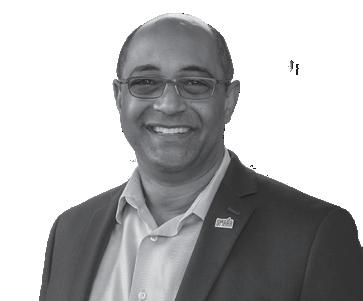
Networking Opportunities: The Chamber provides ample networking opportunities for small business owners. Members can connect with like-minded professionals, potential clients, and industry experts through events, seminars, and workshops. Events such as mixers and educational webinars allow small businesses to showcase their offerings, expand their visibility, and generate potential revenue streams.
Advocacy and Representation: Small businesses often face legislative and regulatory hurdles. The Chamber acts as a powerful advocate, representing its members’ interests at various levels of government. By joining the chamber, small businesses gain a collective voice that can influence policies, regulations, and economic development initiatives in the Greater Omaha area.
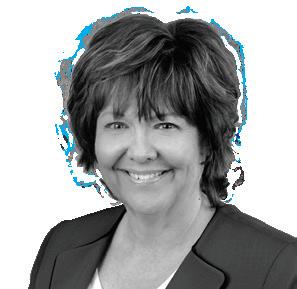
Business Support and Resources: The chamber offers tailored resources and support services to small businesses, including valuable information, market research, and economic data, enabling informed decisionmaking. Mentoring programs, educational seminars, and workshops equip business owners with the knowledge and skills needed for success. From marketing assistance to guidance on financial management, the chamber’s resources empower small businesses and drive growth.
Brand Visibility and Promotion: Being a Chamber member enhances small businesses’ brand visibility. The chamber promotes its members through its website, social media platforms, newsletters, and local publications. Special events and programs, such as awards and business spotlights, increase exposure and credibility. The chamber’s recognition elevates a small business’s reputation and fosters customer trust.
Collaboration and Partnerships: The chamber fosters a collaborative business ecosystem, encouraging partnerships among its members. Small businesses can form strategic alliances, joint ventures, or subcontracting agreements to expand their offerings, reach new markets, and access additional resources. Industryspecific councils and committees facilitate knowledge-sharing and address common challenges.
From networking and advocacy support to business resources and brand promotion, the Omaha Chamber provides a platform for growth and success. Small businesses can tap into the chamber’s vibrant business ecosystem and leverage its resources to thrive in Omaha.
Winsley Durand is VP of Member Services for the Greater Omaha Chamber. B2B Deborah Ward is the executive director of Omaha Convention and Visitors Bureau. OMAHA CVB BY DEBORAH WARD

